-
Plant Name & Description
Botantical Name
-
MaacNificent Amur Maackia Maackia amurensis 'JFS-Schichtel1'
A vigorous-growing Maackia with an elegant vase shape. Leaves composed of multiple leaflets emerge silvery green in the spring, turn a more solid green in summer, then turn yellow in the fall. Reddish-bronze bark exfoliates on older specimens. Tall spikes of dull white flowers turn to flat seed pods. Tolerant of acidic and slightly alkaline soils.
-

Madame Galen Trumpetvine Campsis x tagliabuana 'Madame Galen'
Vigorous woody climbing vine with green leaves and orange/red tumpet-shaped flowers that bloom from late summer into fall. This variety is one of the hardiest and most reliable to grow in most soils. Attracts hummingbirds and some insects. Requires no additional moisture once established.
-
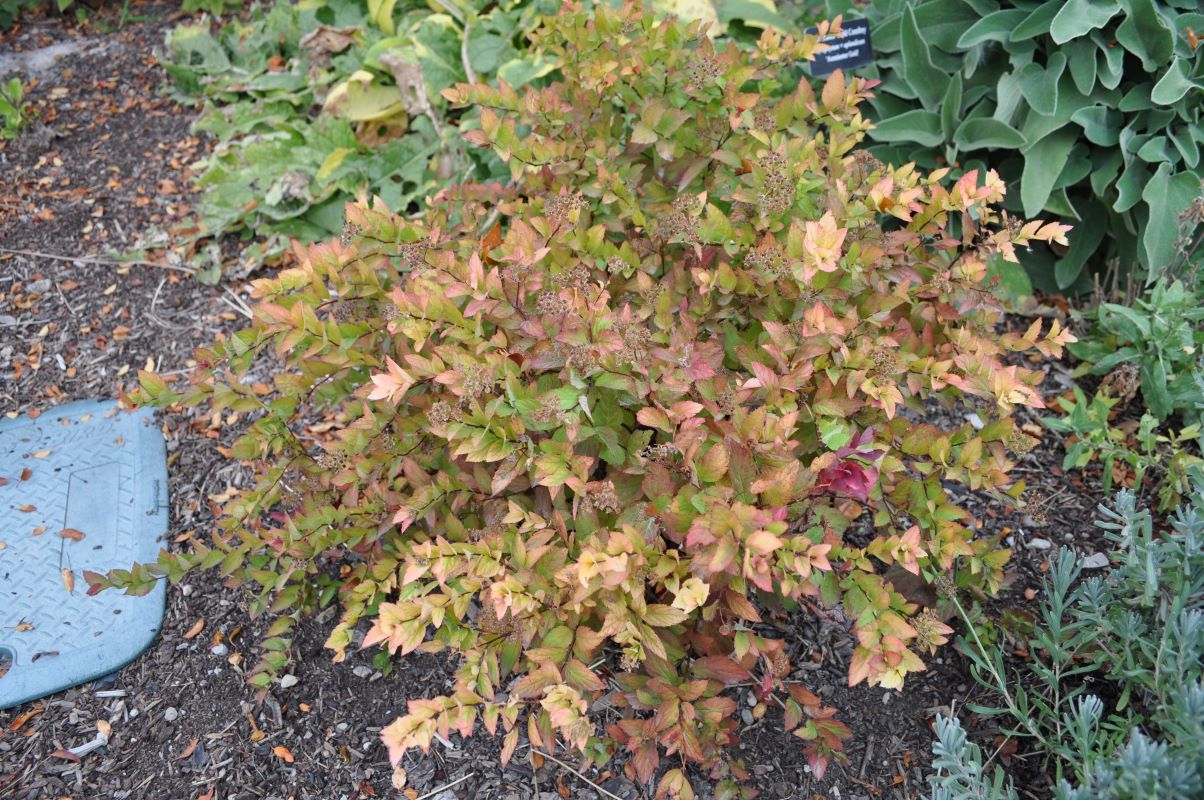
Magic Carpet Japanese Spirea Spiraea japonica 'Walbuma'
Small, rounded deciduous shrub. Produces abundant flat clusters or rose pink flowers in mid to late spring into the summer. Young leaves emerge reddish bronze. Depending on the amount of shade Walbuma is in, mature leaves will range from golden yellow to bright green. Requires significant pruning to promote more flowering.
-
Magnus Coneflower Echinacea purpurea 'Magnus'
Very hardy upright-growing perennial. This variety has large, magenta daisy-like flowers up to 7" across with dark orange centers. Will tolerate some drought once established. Deadheading will prolong the flowering time. Great choice as a specimen or in masses. Looks great in meadows or prairies.
-
Majestic Beauty Tulip Tree Liriodendron tulipifera 'Aureomarginatum'
Golden edged lobed leaves adorn this large deciduous tree. Spring brings tulip shaped orange flowers. It prefers adequate water and acidic soils but may adapt to drier soils once established.
-

Major Wheeler Honeysuckle Lonicera sempervirens 'Major Wheeler'
The most profuse bloomer of the honeysuckle vines, 'Major Wheeler' puts on a display of bright red flowers in spring. Hummingbirds love the tubular flowers and will be seen visiting. It grows fast over trellises and is easy to care for.
-

Majorican Germander Teucrium cossonii subsp. majoricum
This is an awesome evergreen groundcover with thin, silvery gray leaves. The flowers and leaves are very fragrant. With pink-purple flowers, this plant can have a similar look to lavender. It grows well in full sun and likes hot, dry areas with good drainage. Sometimes labelled as Teucrium aroanium 'Majoricum' or Gray Creeping Germander.
-

Male Hardy Kiwi Vine Actinidia arguta
This is a deciduous, fast-growing twining vine that has deep green leaves. The leaves of this woody vine are sharply toothed. The male Kiwi vine does not produce fruit but is used as a pollinator for other female Kiwi vines. It is an aggressive vine requiring support.
-
Mallow Ninebark Physocarpus malvaceous
This Ninebark is loved for its flaky cinnamon colored bark, attractive green foliage and delicate white blossoms that cover the shrub in spring and early summer. The fruit that follows the flowers are inconspicuous.
-
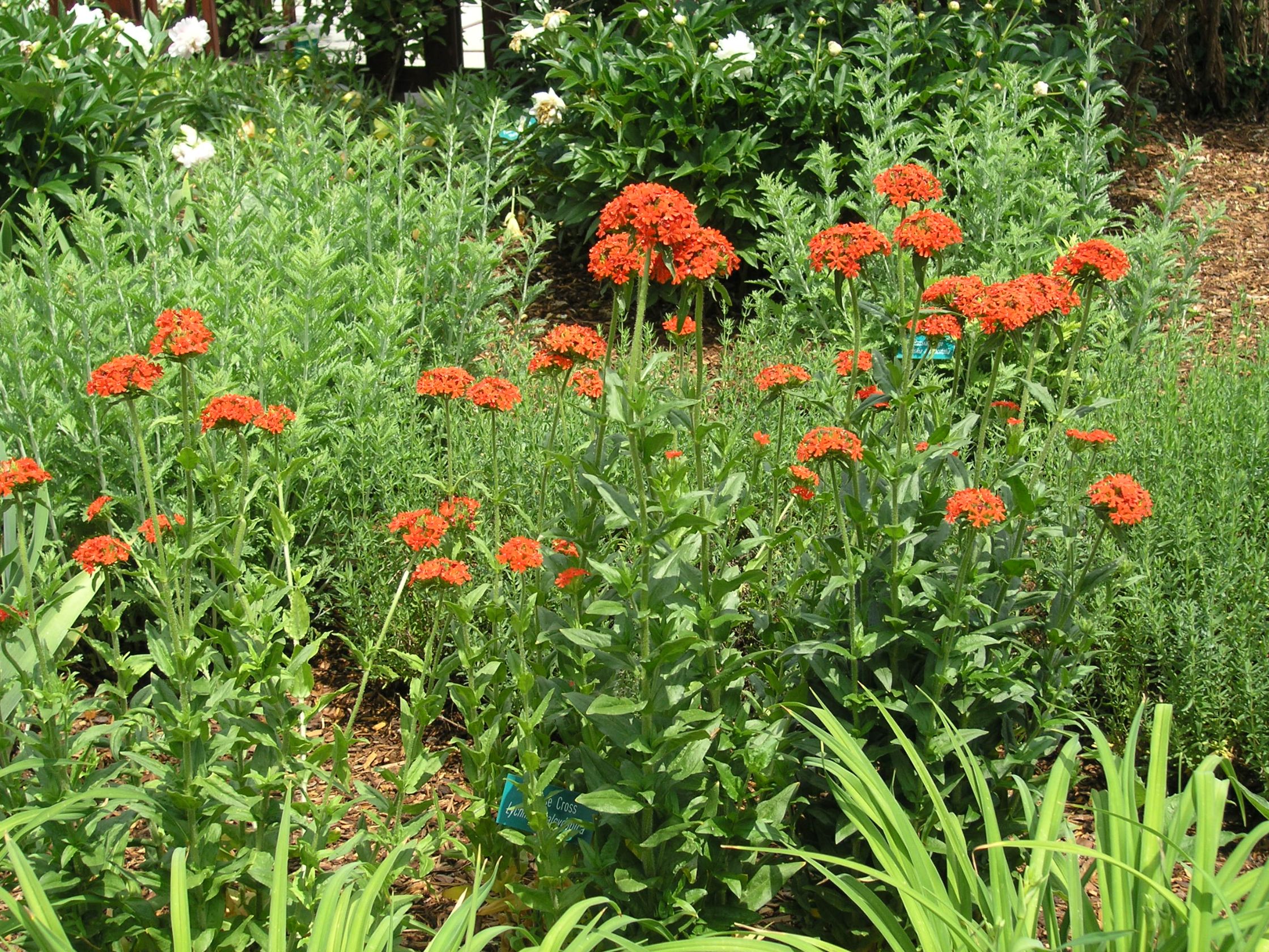
Maltese Cross Lychnis chalcedonica
Upright, stiff perennial that grows best in full sun. Bright orange-red flowers are formed in dense clusters atop 3-4 foot tall stalks with mid-green foliage. Individual flowers are 3-4" in diameter. Has a short bloom season from early summer to mid summer.
-

Mango Lassi Avens Geum 'Mango Lassi'
An evergreen perennial that produces abundant flowers from late-spring into fall. Double petals appear in multi-colored hues of oranges, reds and yellows. The foliages is dark-green with scalloped edges. Prefers to grow with moderate amounts of water.
-
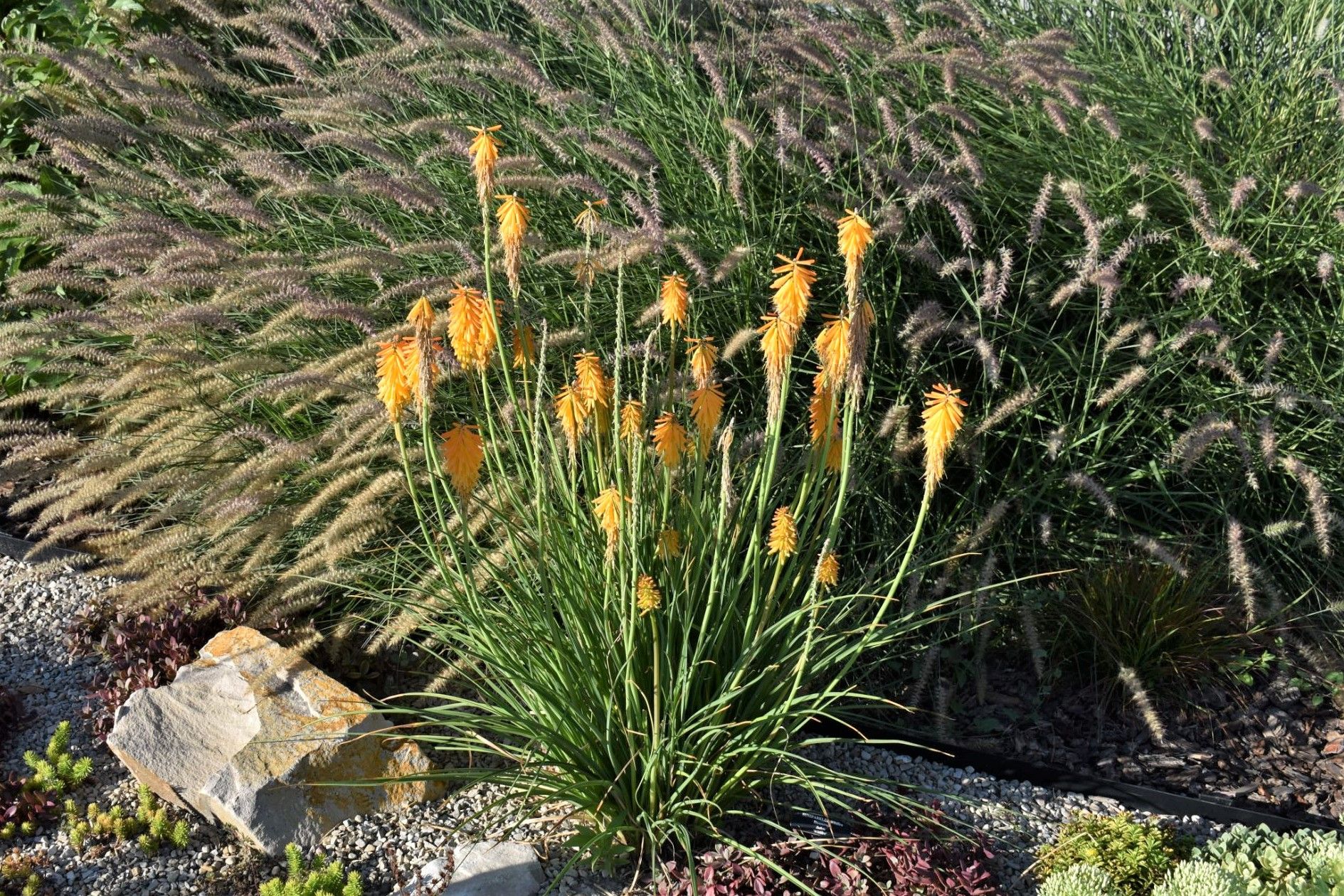
Mango Popsicle Dwarf Poker Kniphofia 'Mango Popsicle'
This amazing drought tolerant plant has great color and texture throughout the growing season. A tidy clump of narrow green foliage produces a continuous bloom of tall orange spikes throughout summer and into fall. The saturated mango-colored flowers attract hummingbirds.
-
Marcus Meadow Sage Salvia nemorosa 'Marcus'
This is a very compact selection of meadow sage making it a great plant for any border. It has spikes of intense violet flowers over a grey-green shrub-like clump of fragrant foliage throughout the summer. This perennial can be planted in mass for a dramatic show.
-
Margarita BOP Penstemon Penstemon heterophyllus 'Margarita BOP'
Semi-evergreen mound-forming perennial with short spikes of long-blooming lavender to magenta flowers. Short linear leaves grow on upright reddish stems. This cross between P. heterophyllus and P. laetus was originally found by Las Pilitas nursery at the Bottom Of the Porch, hence the BOP in the name. Tolerates drought and requires well-drained soils.
-
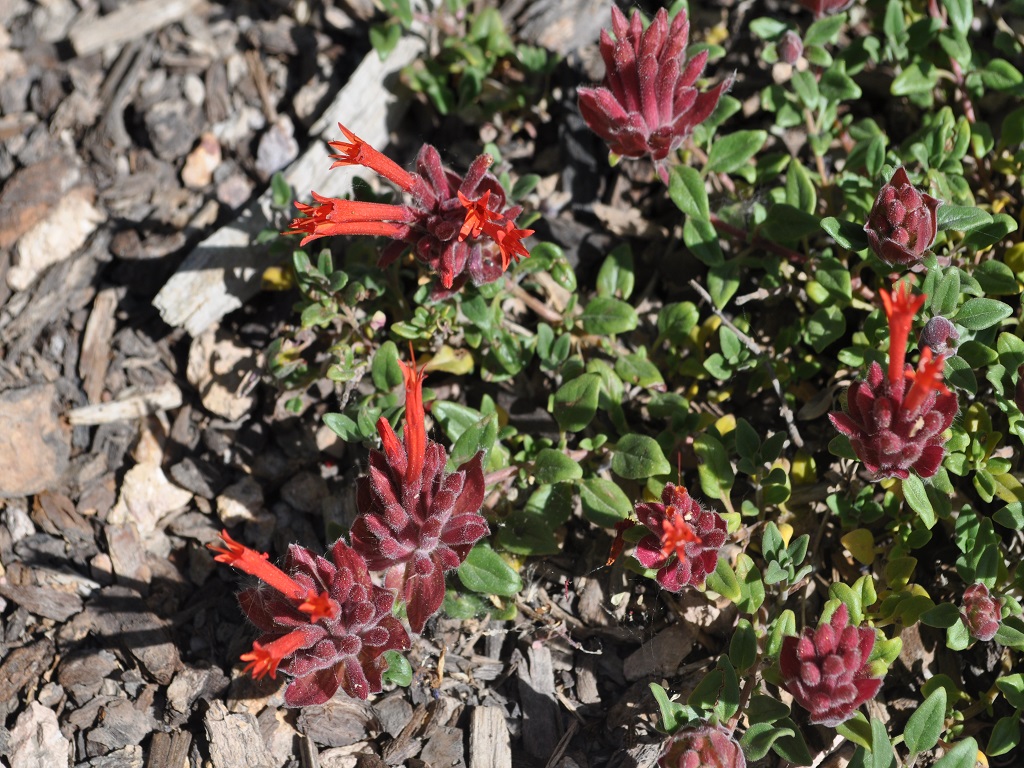
Marian Sampson Monardella Monardella macrantha 'Marian Sampson'
Native to California, this perennial is hardy in the Salt Lake Valley. Scarlet red trumpet-shaped flowers grow in prolific clusters that are very attractive to hummingbirds and butterflies. Small dark green leaves look good in rock gardens. It is difficult to establish, so expect to lose some.
-
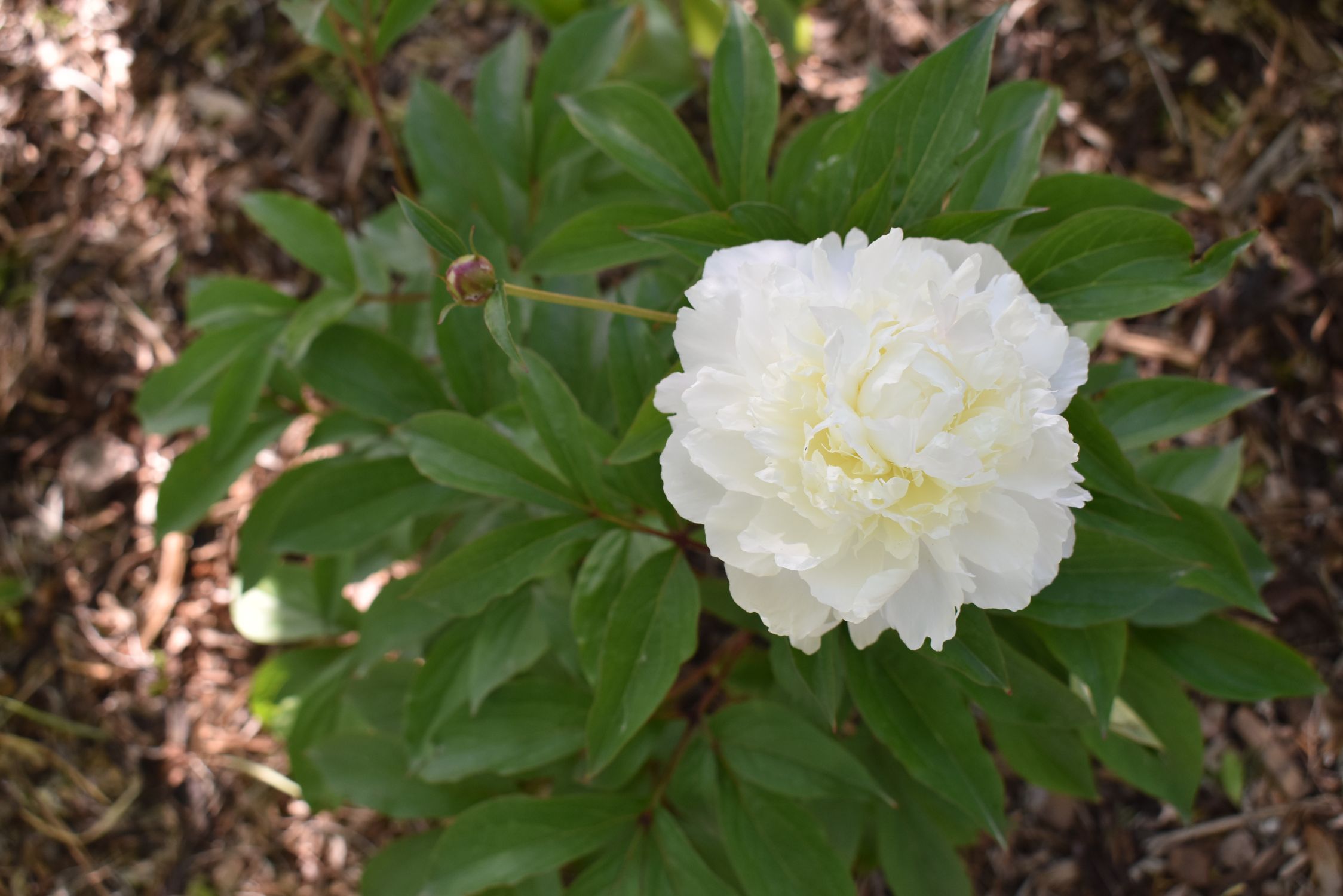
Marie Lemoine Peony Paeonia lactiflora 'Marie Lemoine'
Clump-forming, shrubby, herbaceous flowering perennial. Large double creamy white flower is sweetly fragrant and blooms in late-spring. Deeply lobed glossy green foliage provides appeal even when not in bloom. Makes a superior cut flower. Plant in fertile, well-drained soil. Tolerates some drought once established.
-
Marilee Crabapple Malus 'Jarmin'
This crabapple is narrow and upright in habit. It has a lighter green foliage with double, large white flowers that start off as pink buds. The tree is nearly fruitless and is a good option for streetscapes and utility line areas.
-

Matrona Stonecrop Sedum 'Matrona'
Vase-shaped, upright growing succulent perennial. Flattened clusters of numerous star-shaped pink flowers bloom in late summer to fall. Purplish stems and succulent gray-green leaves tinged bronze provide year round appeal. Tolerates poor soils and drought.
-
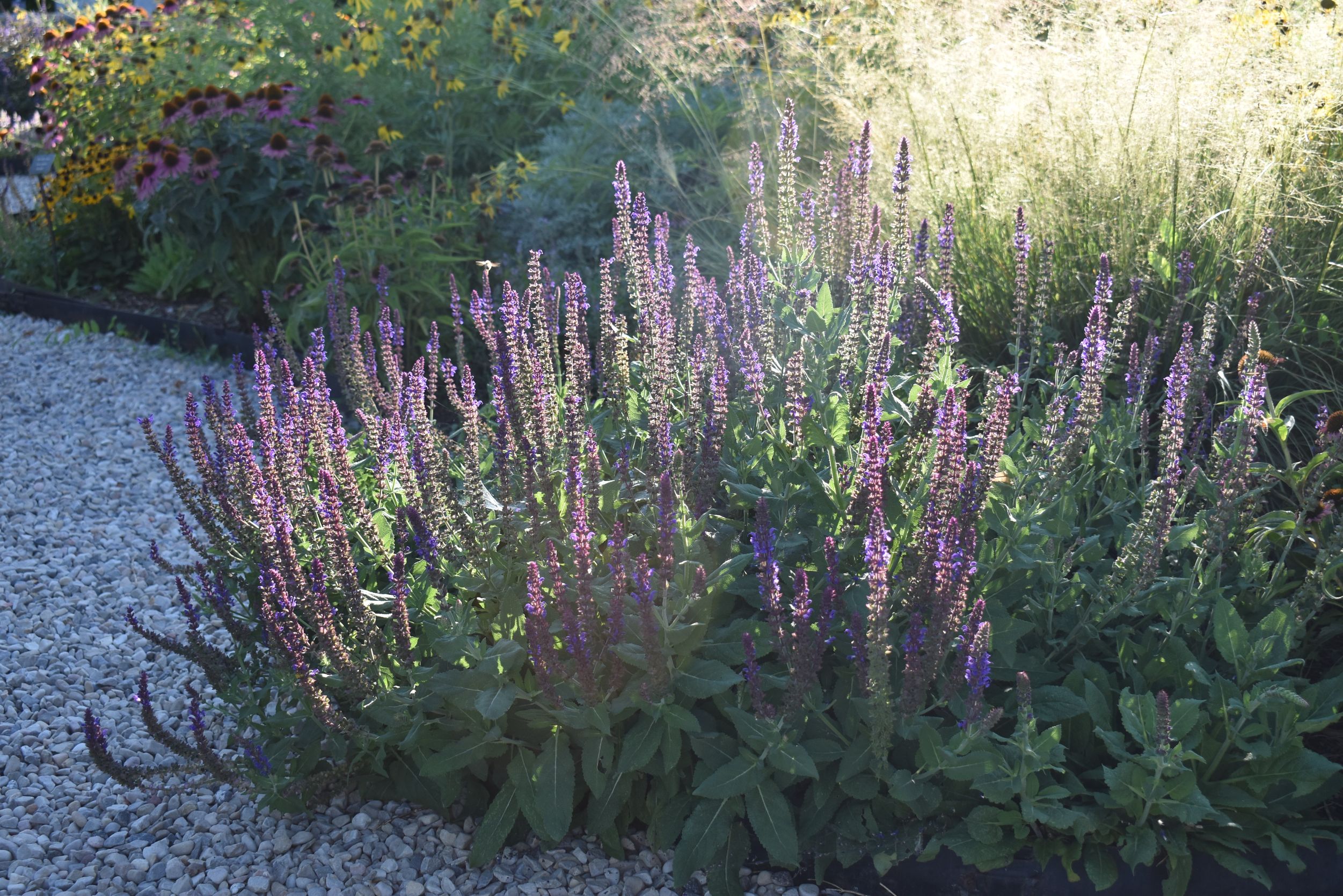
May Night Sage Salvia x sylvestris 'Mainacht'
Upright clump-forming perennial with long-blooming deep-blue flowers starting in early summer. Mid to dark green foliage grows on upright stems which will flop over after blooming. These old stems can be cut back nearly to the ground to promote reblooming. Plant in well-drained soil and do not overwater.
-
McKana Hybrid Columbine Aquilegia (McKana Group)
One of the best know varieties of columbine. Bears multi-colored flowers in spring, ranging from pastel shades of blues, reds, and yellows. Attractive green fern-like foliage adds beauty to the garden during the rest of the year. Developed from a mix of North American species.
-
McKay's White Shrubby Cinquefoil Potentilla fruticosa 'McKay's White'
Very adaptable shrub with irregular growth. Lush compact growth and mid to dark green foliage are very attractive. Creamy white flowers appear in summer and last until fall. Great choice for providing lushness to a difficult landscape. Regular pruning of dead branches will keep this shrub looking nice. Recently moved to the genus Dasiphora but still more commonly referred to as Potentilla.
-
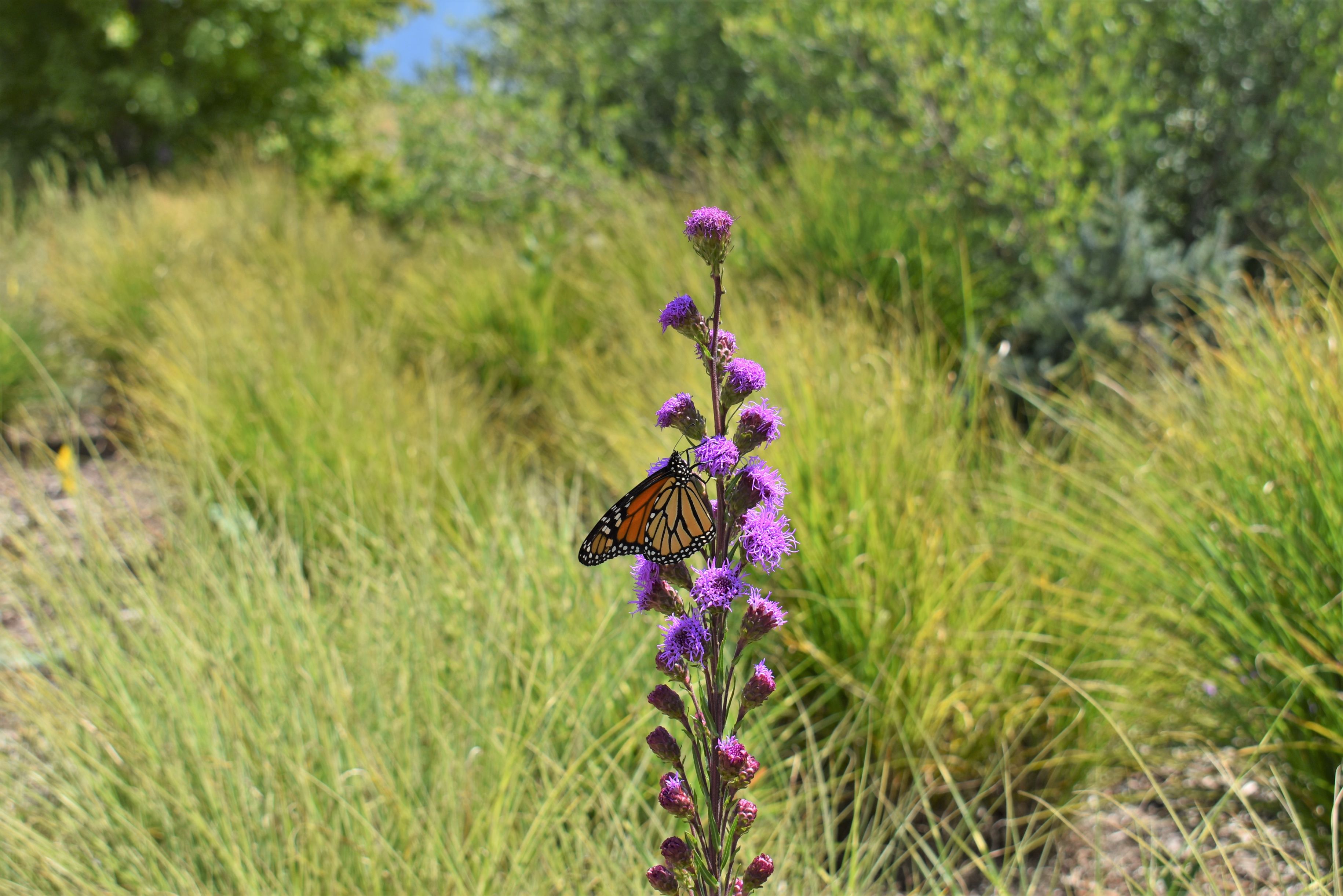
Meadow Blazing Star Liatris ligulistylis
A wild-looking perennial that offers delicious nectar for many pollinators, especially Monarch butterflies. Tall slender stems are covered in tiny, vibrant purple, thistle-like blossoms in the later parts of summer, offering a perfect stop for the Monarchs on their migration south. The flower stalks stand tall and erect, making them a beautiful vertical addition to planting beds. In ideal conditions it can grow up to 5’, but typically it will stay closer to 3’.
-
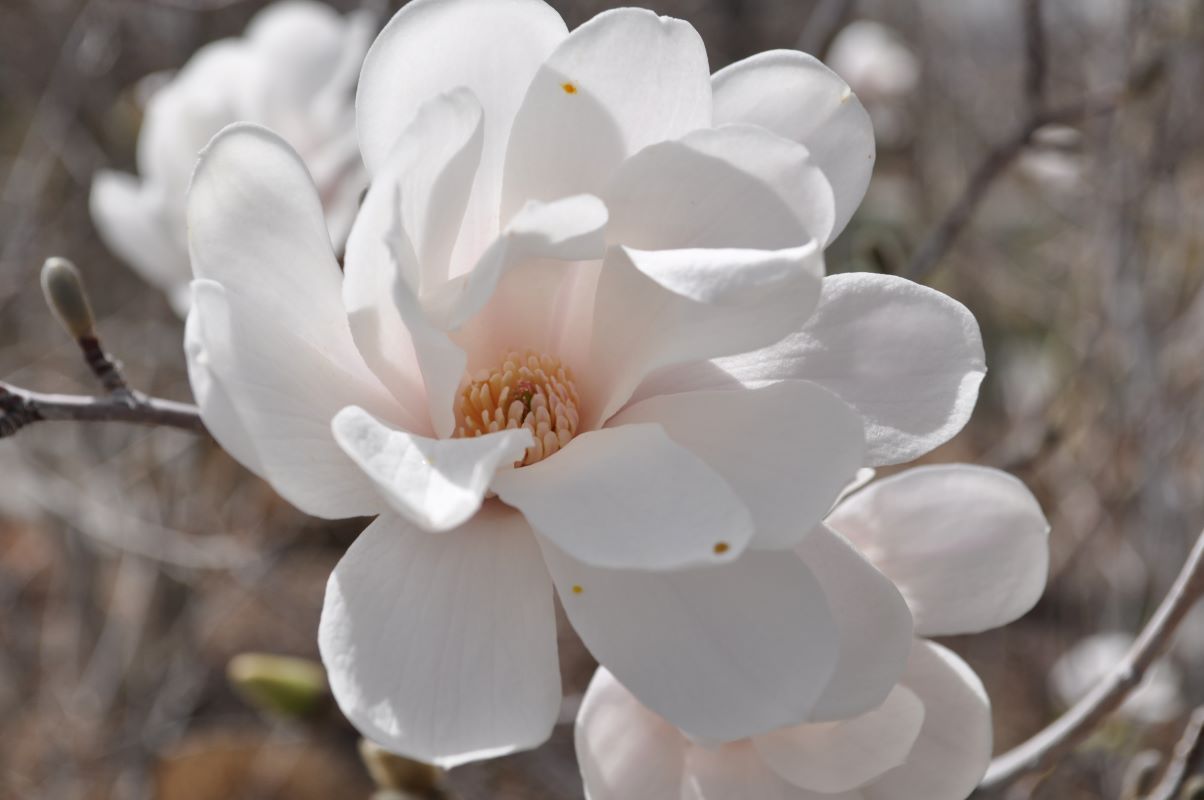
Merrill Magnolia Magnolia x loebneri 'Merrill'
Small deciduous flowering tree. Produces large, 15 petaled, white fragrant flowers in spring, which bloom prior to the emergence of leaves. Has dark green summer foliage turning to yellow in fall. Prefers fertile soils and moderate waterings. Plant in an area to showcase the spring blossoms.
-

Mesa Verde Hardy Ice Plant Delosperma 'Kelaidis'
This freely branching, mat forming ice plant has jellybean shaped foliage that may become flushed with purple in the winter. From May until fall beautiful salmon-pink blossoms with yellow centers densely cover the fleshy foliage.
-
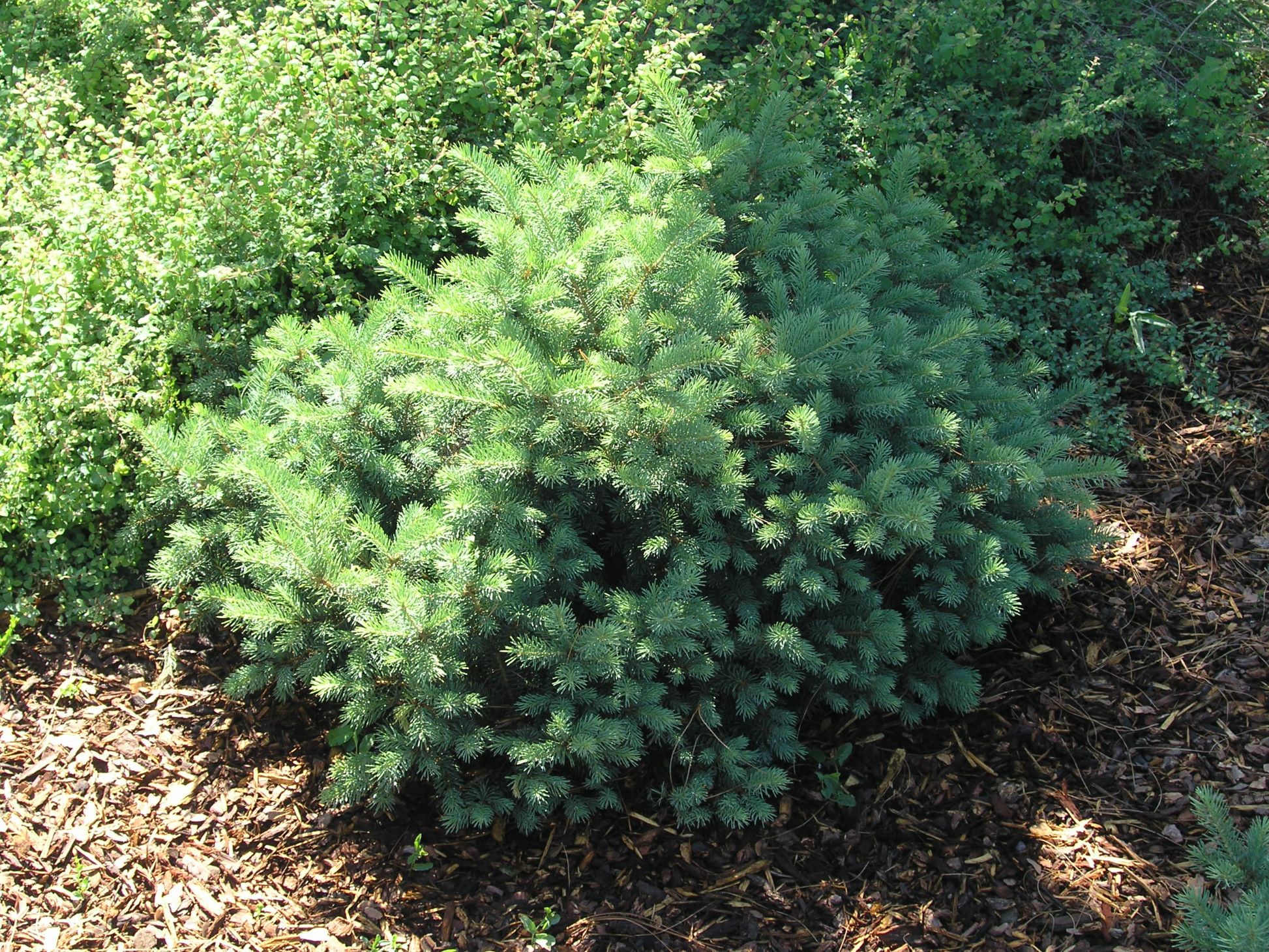
Mesa Verde Spruce Picea pungens 'Mesa Verde'
A compact variety of Blue Spruce with sharp pointed four sided, green needles 1/2" to 1 1/2" long, arranged radially on the shoots. This variety is usually greener than the rest of the species. Noted for its exceptional tolerance for poor soils and difficult sites.
-
Mexican Feather Grass Nassella tenuissima
This ornamental grass will provide beautiful movement and energy in the landscape with its hair like, extremely fine and flowing light green foliage. A cool-season grass that can hold onto its color for much of the year (may brown as temperatures are at their highest in the summer). Late spring into the early summer brings wispy, wheat colored seed heads that highlight the swaying foliage below. Mexican Feather Grass is self-seeding so plant in an area where it is desired for it to spread or where it can be easily controlled.
-
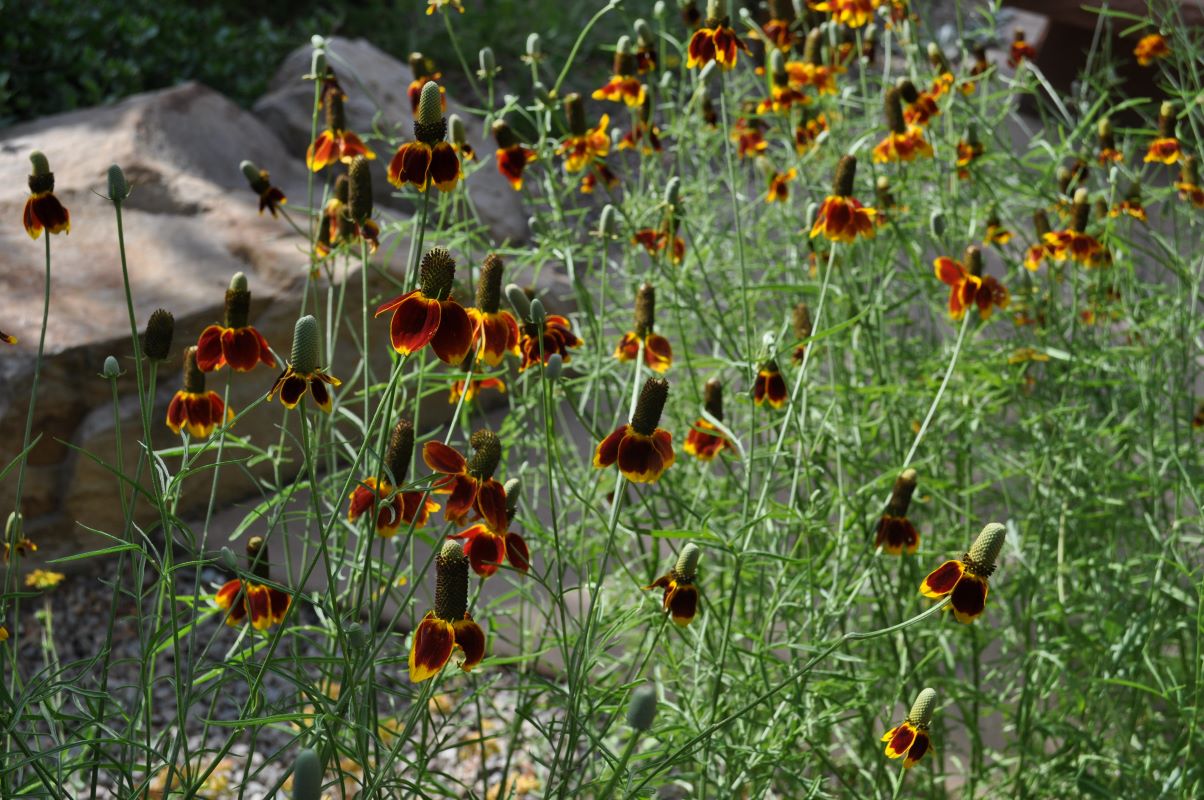
Mexican Hat Ratibida columnifera
A fun, fast growing daisy-like flower that requires no water once established. Long-blooming flowers may be fully yellow or dark burgundy with yellow edges. The hat-shaped flowers have green-to-brown cone-shaped centers with petals hanging from the bottom edge, similar to the closely related Black-eyed Susan. It blooms best in full sun but otherwise tolerates a range of environments.
-
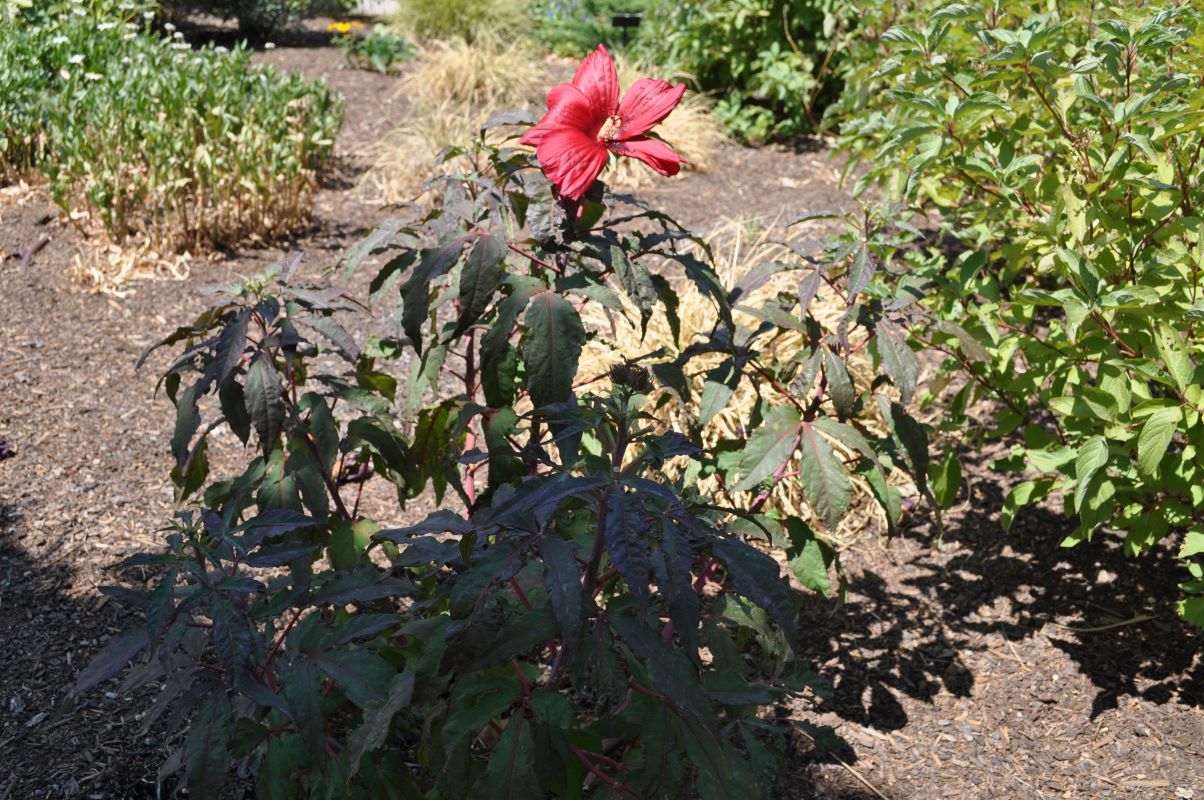
Midnight Marvel Hardy Hibiscus Hibiscus moscheutos 'Midnight Marvel'
A large, summer blooming shrubby perennial that has large, tropical looking, deep red flowers. The flowers appear in mid-summer and continue until frost. The leaves are maple shaped and burgundy. It works best in full sun, but will tolerate some light shade.
-
Midnight Model Meadow Sage Salvia pratensis 'Midnight Model'
Large, leathery leaves hold up tall spikes of vibrant blue-purple blossoms. Flowers attract butterflies, hummingbirds and bees and are good for cut flowers. Midnight Model will perform at its best in full sun.
-
Midwinter Fire Dogwood Cornus sanguinea 'Midwinter Fire'
An upright deciduous shrub with orange-yellow to red winter shoots and mid-green leaves 4" long, turning golden yellow to red in autumn. From May-June, bears white flowers in clusters up to 2" across followed by dull blue-black fruit. Fruit is not showy, but is attractive to birds. Prefers full sun and well drained, moist soil.
-
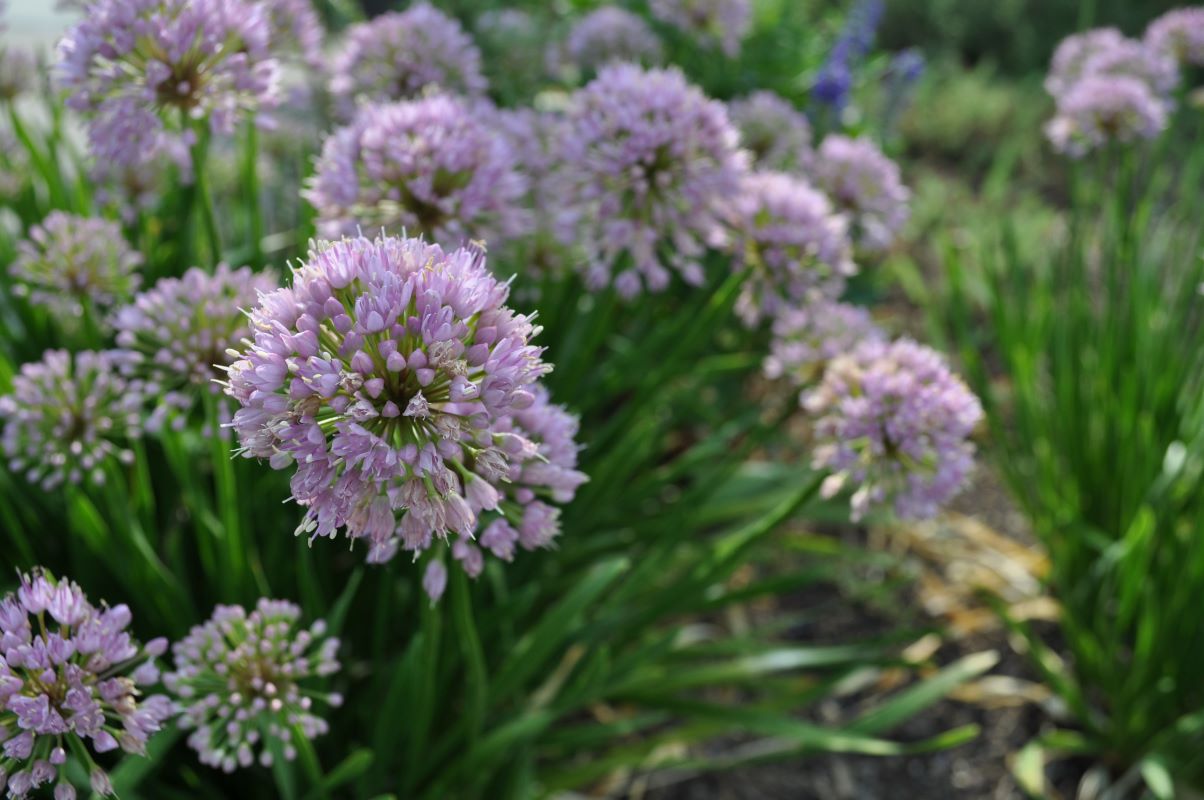
Millenium Ornamental Onion Allium 'Millenium'
Millennium is a great ornamental onion. Blooming in mid-summer the large globe rose-pink flowers make a striking appearance. Foliage grows from the base, green and grass-like. Attracts bees and butterflies and is fragrant.
-

Millstone Japanese Pagodatree Sophora japonica 'Halka'
Deciduous tree with rounded to oval form. Lustrous green leaves are composed of multiple leaflets. Leaves turn bright yellow in the fall. Creamy-white blooms are formed in the summer and forming seed pods in late-summer. Tolerates many soil types and conditions. Less susceptible to stem canker than the species.
-
Mimosa Albizia julibrissin
A small, showy, fast-growing deciduous tree. Branches spread out forming a domed crown. Bipinnately compound mid to dark green leaves are fern-like. Fluffy pink flower heads bloom throughout the summer eventually turning to long seed pods. Very tolerant of many soil types and very resistant to drought but will grow better with sufficient irrigation. Susceptible to many diseases. Average life-span is 10-20 years. Known to be very invasive in many areas of the United States. Not known to be invasive in Utah, but plant with care.
-
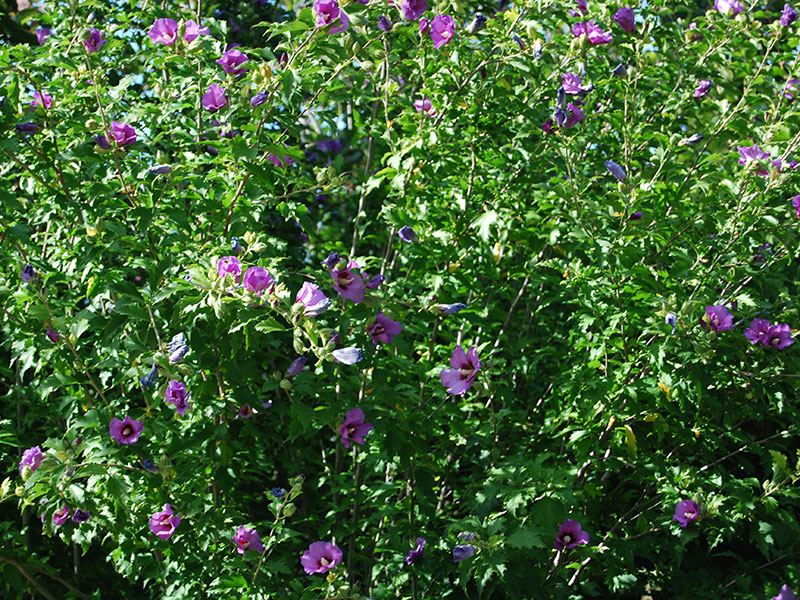
Minerva Rose of Sharon Hibiscus syriacus 'Minerva'
Vigorous, multi-stemmed, upright, deciduous flowering shrub. Numerous showy, lavender-pink, 5-petaled flowers with dark red eyes are borne throughout the summer. Attractive 3-lobed, coarsely toothed leaves grow on erect stems. Tolerant of heat, drought, and poor soils. Prefers fertile soils with moderate amounts of water.
-
Mini Man Dwarf Manchurian Viburnum Viburnum burejaeticum 'P017S'
‘Mini Man’ brings a compact stature to the multi-season appeal of the Manchurian Viburnum, with clusters of bright white flowers in the spring, thick, textured leaves in the summer, red-black fruit that stays on the plant, and red foliage in the fall. A native of Russia, this low-maintenance shrub can handle extreme cold and a variety of soil types.
-

Miniature Mat Daisy Bellium minutum
A shade loving groundcover that offers a thick mat of small, spoon-shaped leaves. Daisy-like white blooms with yellow centers cover the plant from late spring through the summer. It can handle moderate foot traffic.
-
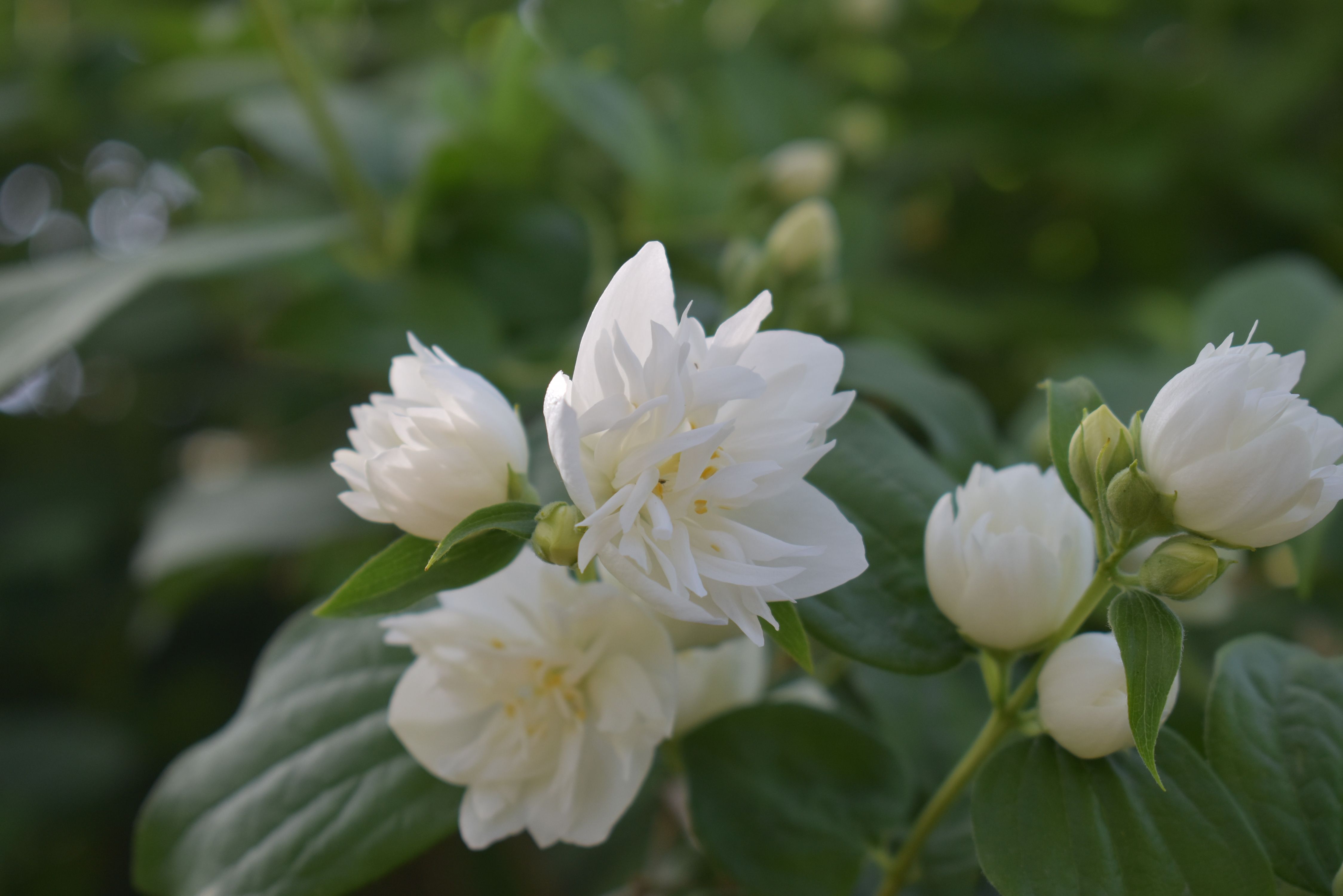
Minnesota Snowflake Mock Orange Philadelphus x virginalis 'Minnesota Snowflake'
Multi-stemmed deciduous shrub with upright arching brances. Profuse white flowers are double and very fragrant. Blooms begin in late spring and last up to 4 weeks. Tolerates some shade but produces more flowers in full sun. Requires low to moderate amounts of water. Adaptable to many soil types.
-

Miracle Coral Bells Heuchera villosa 'Miracle'
A clump-forming coral bell that is appreciated for its color changing foliage. Springtime leaves emerge in a bright chartreuse color with red accents. As summer approaches they mature to a brick red edged in chartreuse and golden yellows. In early summer, dainty, light pink blossoms sit atop long, slender stems that rise high above the colorful foliage.
-
Miss Kim Lilac Syringa pubescens ssp. patula 'Miss Kim'
A compact, bushy, deciduous shrub with terminal panicles of lavender to light blue fragrant flowers that bloom in spring. Lance shaped glossy green leaves turn burgundy in autumn. Prefers moderate amounts of water in well drained soils. Best flowering occurs in full sun.
-

Miss Manners Obedient Plant Physostegia virginiana 'Miss Manners'
A well-behaved North American wildflower that forms a clean, compact clump. It is non-spreading and produces white snapdragon-like blooms that make a nice cut flower. This cultivar is less prone to flopping.
-

Miss Molly Butterfly Bush Buddleja 'Miss Molly'
Compact, fragrant deciduous shrub. Pink-red flowers attract butterflies and hummingbirds in the summer. Flowers bloom in clusters and can be deadheaded for a cleaner look.
-

Miss Piggy Heartleaf Bergenia Bergenia cordifolia 'Miss Piggy'
Large clusters of bubblegum-pink flowers bloom earlier in spring than most perennials. Mounds of broad, glossy, dark green leaves stay green through the winter. Looks great planted in groups under trees and tall shrubs.
-
Missouri Evening Primrose Oenothera macrocarpa
A vigorous perennial with trailing, hairy, often red-tinted stems branching from a central root. Large bright yellow blossoms open up to 4" in diameter in the early evening. Useful as a ground cover. Prolific self seeder and if conditions are right, may become somewhat invasive and require control.
-
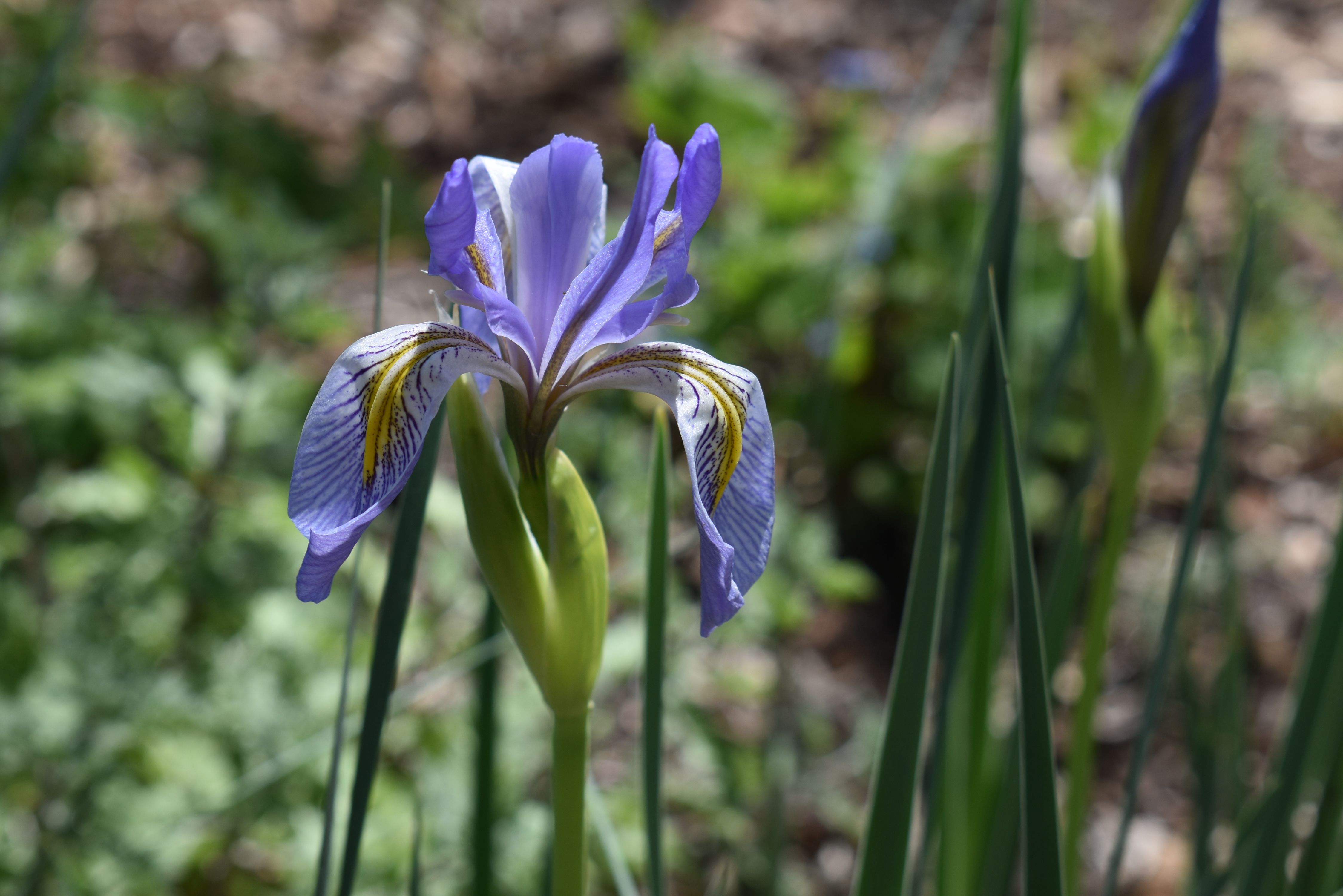
Missouri Iris Iris missouriensis
A variable, beardless iris with narrow leaves to 20 inches, overtopping the flowers. Each branched stem bears 2-4 flowers 2.5-3 in. across. Blossoms are pale to deep blue or lilac/purple having larger falls with deep purple veining. Blooms from May-June. Best grown in full sun and well drained, slightly acidic soil.
-
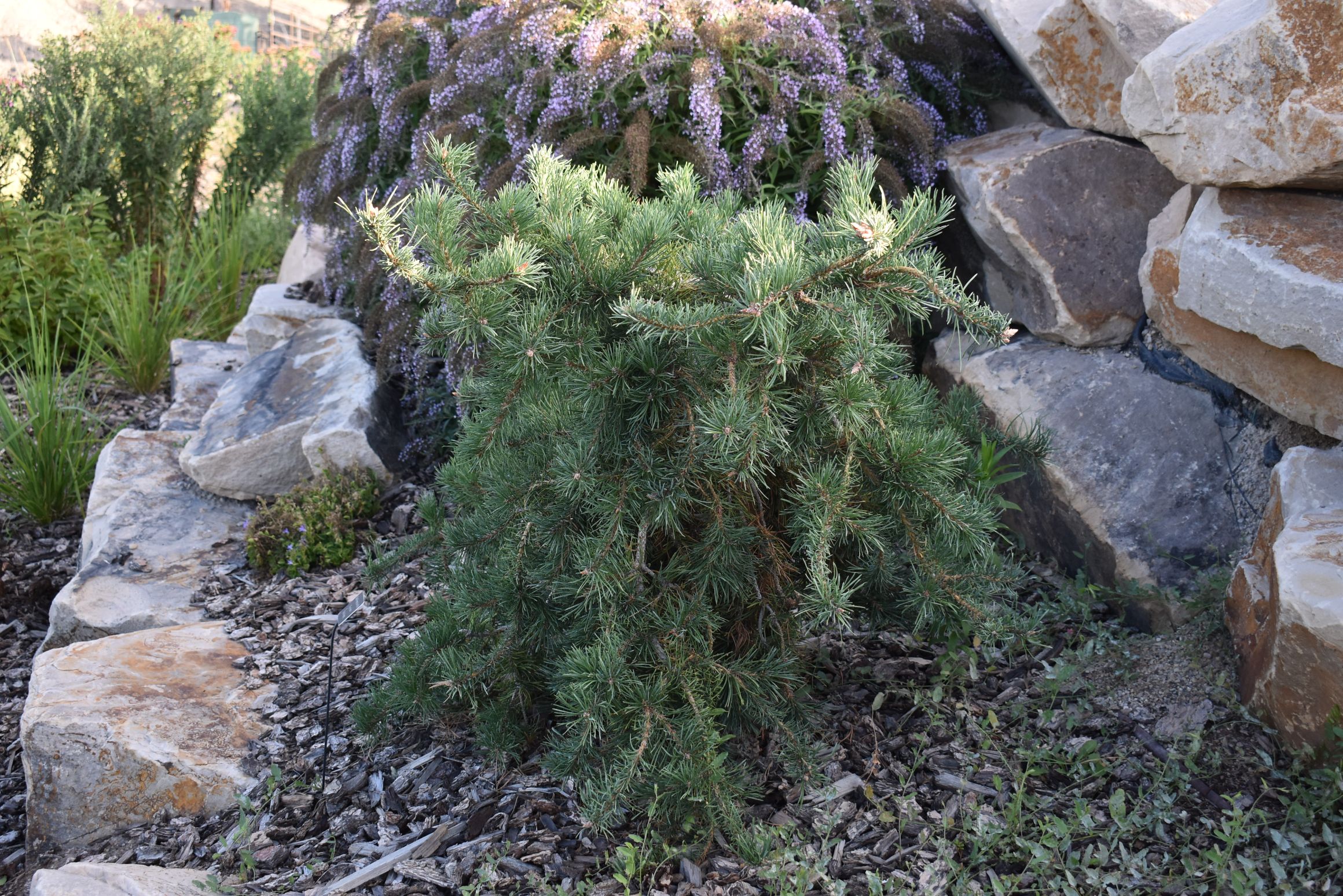
Mitsch Weeping Scots Pine Pinus sylvestris 'Mitsch Weeping'
Contorted, weeping, finely textured branches full of green needles—all the reasons why this Scots Pine is a beautiful centerpiece in the landscape. Whatever height it is staked at, the long arching branches will flow to the ground creating movement and interest.
-

Mohave Lotus Lotus rigidus
Wiry stemmed, shrubby perennial native to southwestern United States and northwestern Mexico. Stunning bright yellow flowers tinged with red and orange bloom from early to mid-spring turning to slender pods in summer. Green palmate or pinnate leaves grow sparsely on long thin stems. May not be readily available for sale. Grows well in hot dry locations.
-
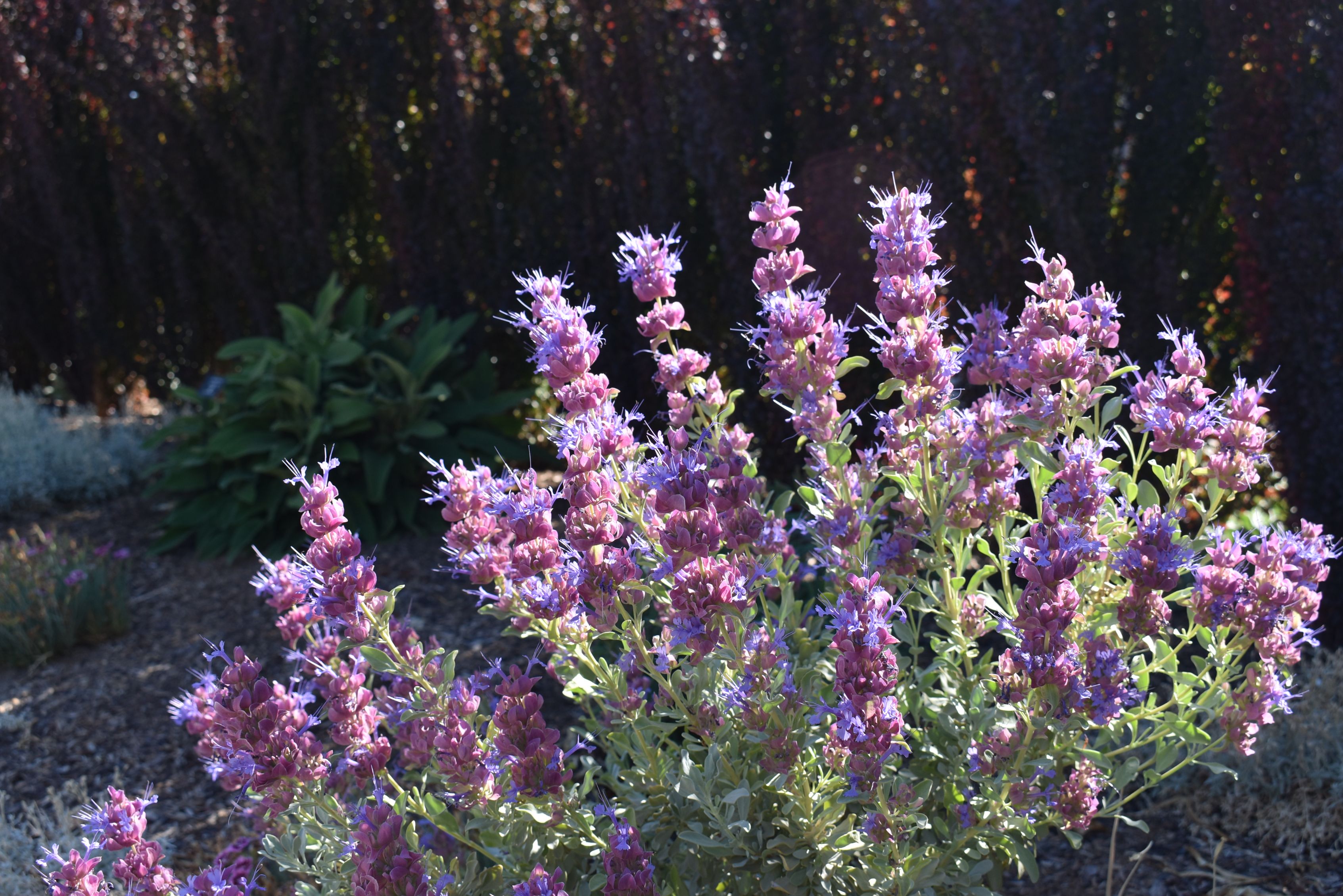
Mojave Sage Salvia pachyphylla
Small, low-maintenance evergreen shrub with silvery-green foliage provides interest throughout the year. Clusters of tall fuchsia-purple flowers bloom continuously throughout the summer. Resistant to mammal browsing due to its pungency. Plant in well-drained soils. Does best in sunny, hot locations.
-
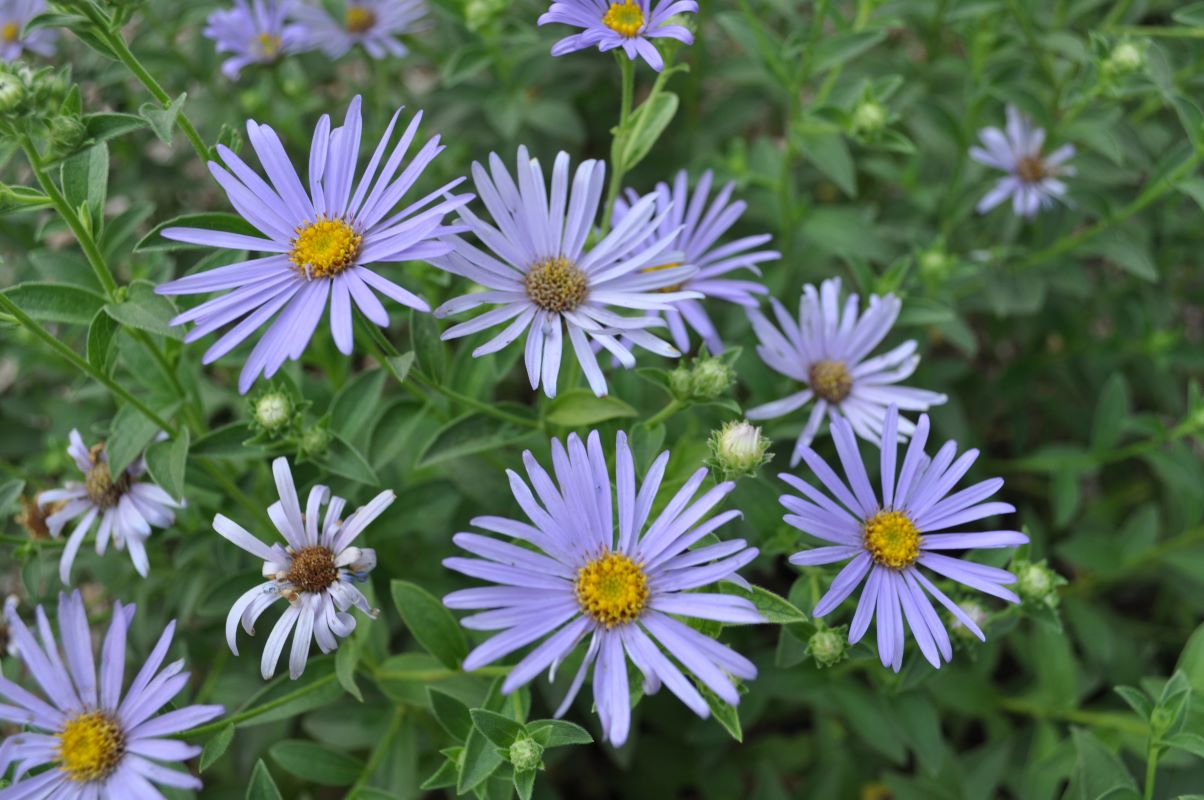
Monch Aster Aster x frikartii 'Mönch'
This free flowering compact perennial has many large, long-lasting flowers with slender lavender-blue petals in summer to early autumn. Oblong leaves are green. Generally resistant to disease. Avoid overwatering and wet winter soils.
-
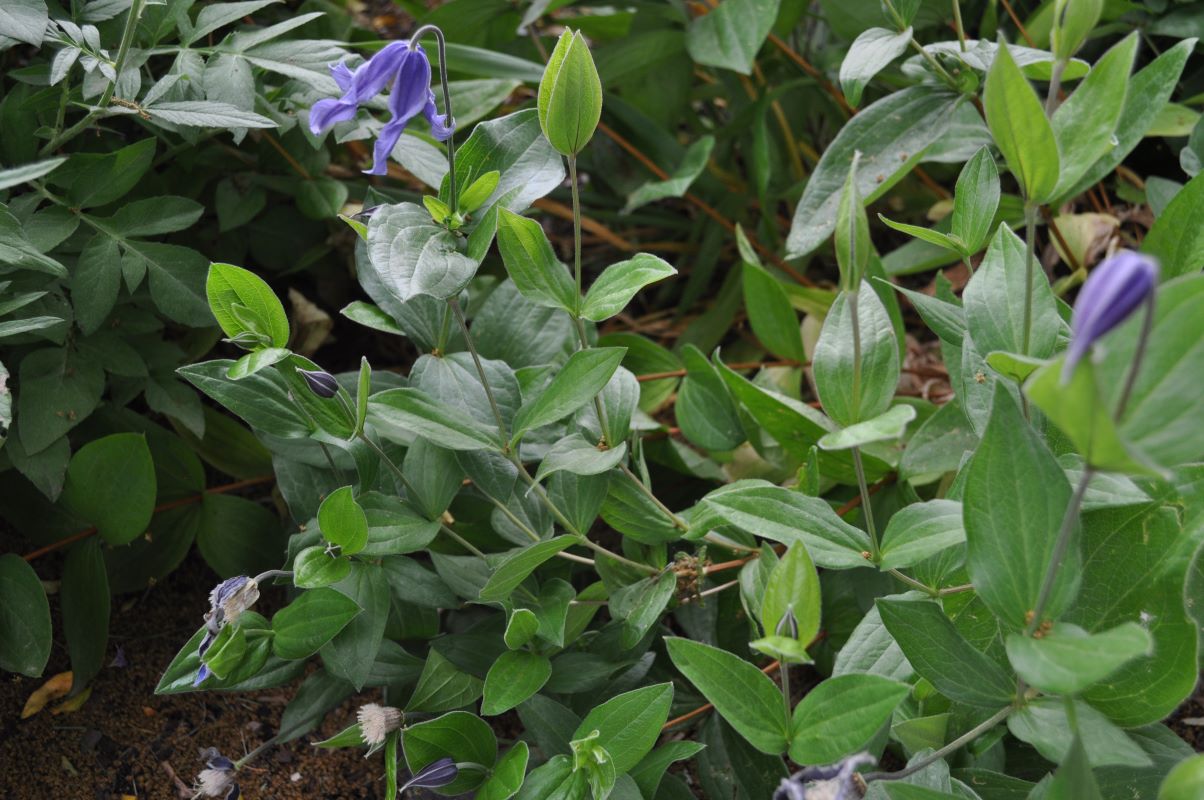
Mongolian Bells Clematis Clematis integrifolia 'PsHarlan'
A compact variety of clematis. It does not need staking and is well suited for edgings and borders. Bell shaped blooms of pink, white, lavender and blue appear in May and continue until September. The plant can be cut back to the ground after the first flush of blooms to encourage upright growth or it can be left to form attractive seed heads in the fall.
-
Montgomery Blue Spruce Picea pungens 'Montgomery'
An evergreen shrub that stays compact and round when young. As it matures (and if left unpruned) it can become a more squat conical shape tree with dense branching. It does grow slowly. Blue-grey needles are short and quite sharp. Great choice for accent planting and to provide winter interest in small areas. Requires plenty of water during establishment period to ensure proper root development. Becomes more drought tolerant with age.
-
Moonbeam Coreopsis Coreopsis verticillata 'Moonbeam'
Has graceful, airy, fern-like foliage with tiny light to lemon yellow daisy-like flowers and darker yellow centers. The blossoms begin in early summer and can last well into the fall. One of the most drought tolerant of its varieties. Great for perennial yards or for containers. Requires full sun and dry to medium-moist soils.
-
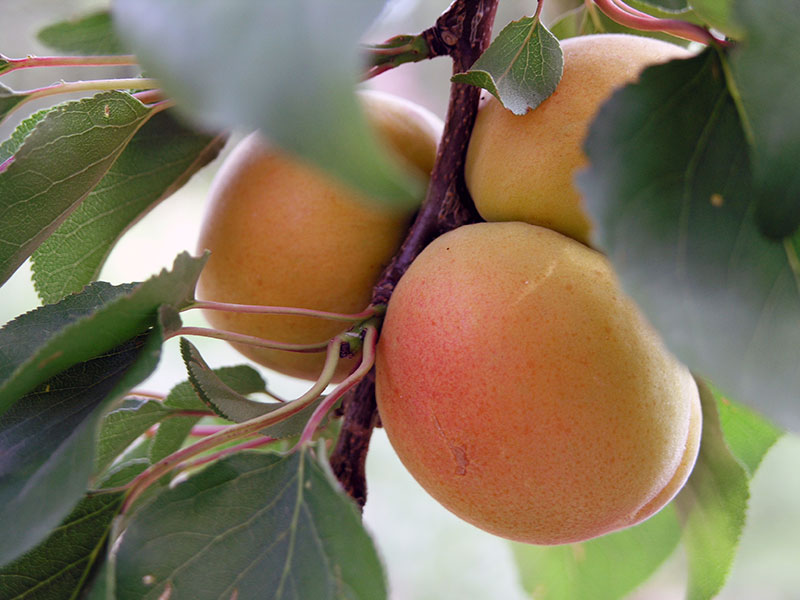
Moongold Apricot Prunus armeniaca 'Moongold'
Small, deciduous, fruit bearing tree. Flowers bloom white in spring becoming small peach-like fruits that ripen in late-July. Apricots tend to be very adaptable to dry conditions. Fruit is best when moderate water is provided and when they are properly maintained.
-
Moonlight Scotch Broom Cytisus scoparius subsp. maritimus 'Moonlight'
This deciduous shrub is made up of extremely slender stems that are covered with tiny, bright green leaves. Large, pale-yellow blooms appear in late-spring and early-summer turning to black pods later in the year. Native to western Europe but adaptable to dry conditions.
-
Moonshine Yarrow Achillea 'Moonshine'
Upright growing herbaceous perennial with fern-like foliage and flat-topped flower clusters. Small bright-yellow blooms begin flowering in early-summer and continue until the fall. Gray-green aromatic foliage is unappetizing to deer. Grows well in many soils and with low amounts of water. Clumps will spread but not uncontrollably.
-
Moonstone Red-Hot Poker Kniphofia 'Moonstone'
This perennial has fleshy grass-like leaves that grow in a clump. Tubular, yellow to ivory flowers grow in clusters on top of long stems. The leaves are mid-green and not too showy, but are easy to maintain when not flowering. Red hot pokers are robust plants that require some water but will handle drought.
-
Moonswirl Coreopsis Coreopsis grandiflora 'Moonswirl'
The semi-double flowers of this tickseed cultivar resemble marigolds, with layers of ruffly, yolk-yellow petals. This exceptionally long-blooming perennial will bring a pop of color even to hot, dry spots and will spread and naturalize under ideal conditions.
-
Mops Mugo Pine Pinus mugo 'Mops'
This dwarf variety of mugo pine has a dense rounded form that grows no taller than 3-4 feet. It is a slow grower and will take many years to reach its maximum height. The mid to dark green needles are 1-2" long and grow in bundles of two. It tolerates many soil types and does best with moderate water.
-

Mora County Mix Chocolate Flower Berlandiera lyrata 'Mora County Mix'
Add the scent of chocolate to your garden with this cheerful, long-blooming perennial. Bright yellow flowers open in the mornings from spring through late summer and then close with the heat of the day. This variety is hardier than the species and can handle colder climates. It is adaptable to heavy soils and does not require additional water once established. The seeds provide food for birds.
-
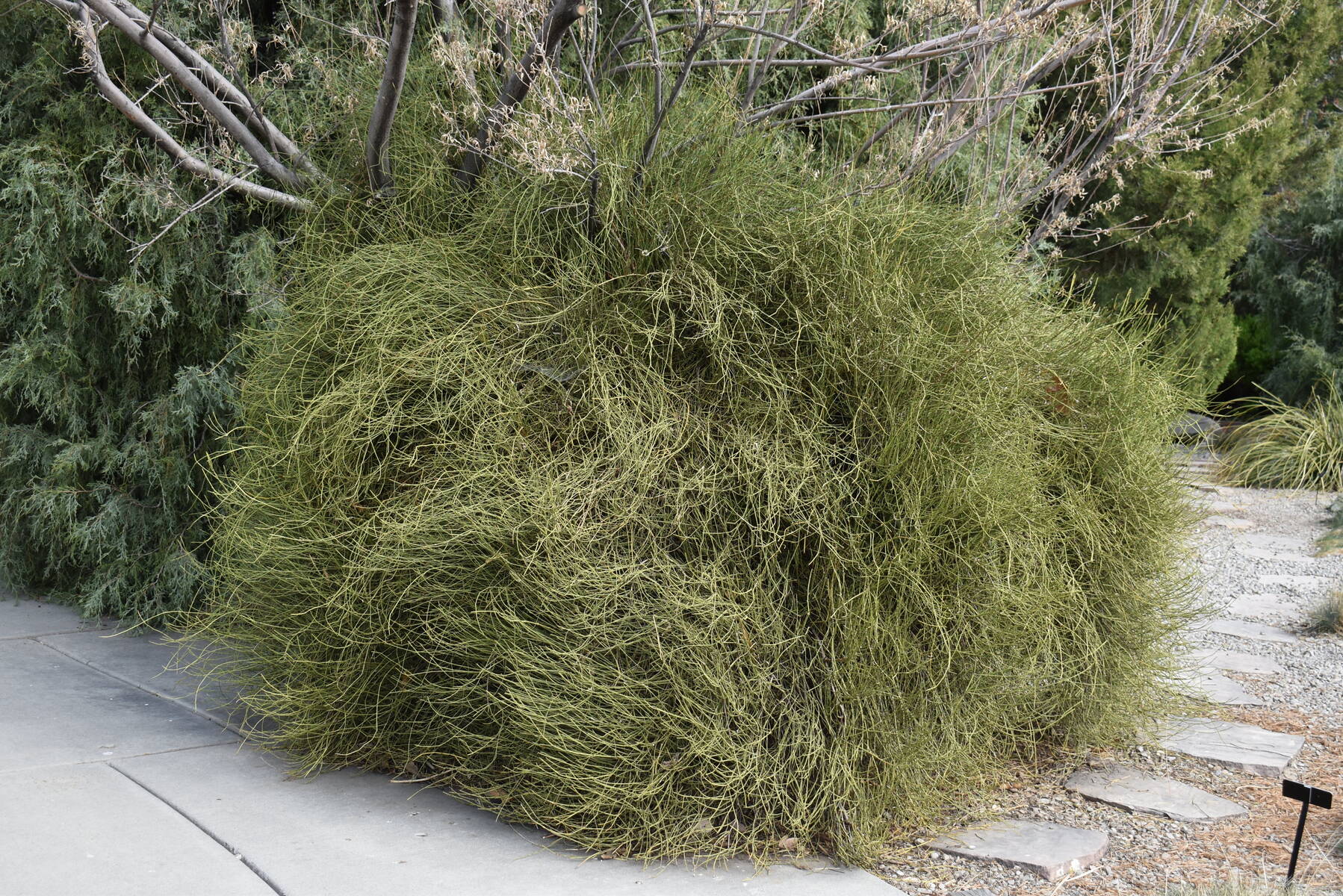
Mormon Tea Ephedra viridis
Leafless evergreen shrub with bright green wiry stems. Stems are finely furrowed and jointed growing in broom-like structures. Flowers are inconspicuous. Allegedly used by Mormon pioneers to make a medicinal tea. Very drought tolerant. Needs no additional water but requires well-drained soils. Survives in very tough conditions in nature.
-
Morning Light Maiden Grass Miscanthus sinensis 'Morning Light'
Arguably one of the best grasses of the Miscanthus genus. Similar in many respects to 'Gracillimus' including the rounded form and narrow leaves. Creamy yellow leaf margins providing an overall silvery appearance. Small red flowers appear in late-summer to fall turning tan in winter. Cut down to 4-6" above the soil in late-winter or early spring before new growth occurs.
-
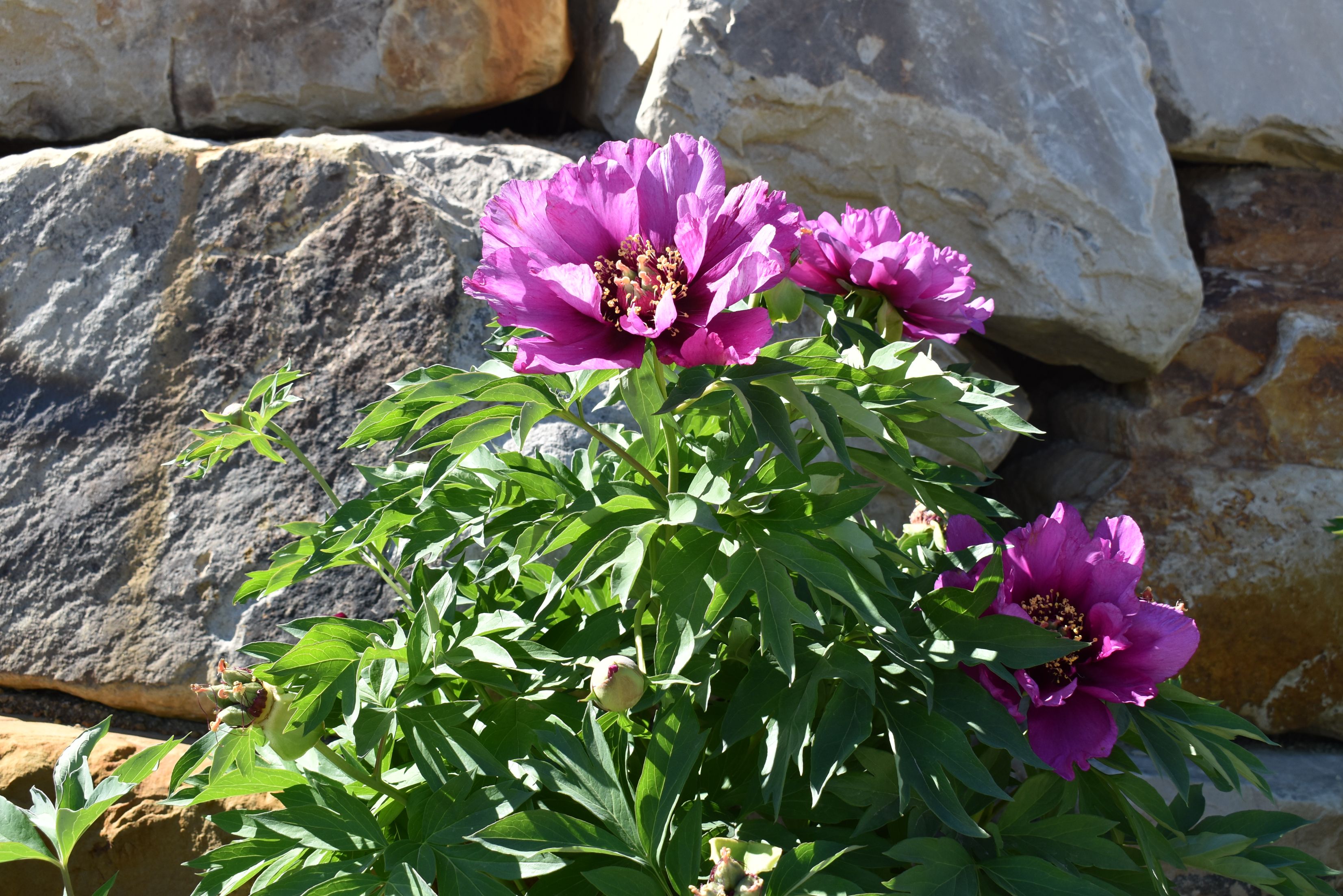
Morning Lilac Itoh Peony Paeonia 'Morning Lilac'
An abundance of large, aromatic, single to semi-double, magenta blossoms cover this plant in the late spring. To compliment the vibrant petals there are radiant gold stamens and white highlight accents. These blossoms sit just above the attractive green foliage on sturdy stems, making for great cut flowers. Itoh peonies, or intersectional peonies, are hybrids of the tree peony (P. lemoinei) and garden peony (P. lactiflora).
-
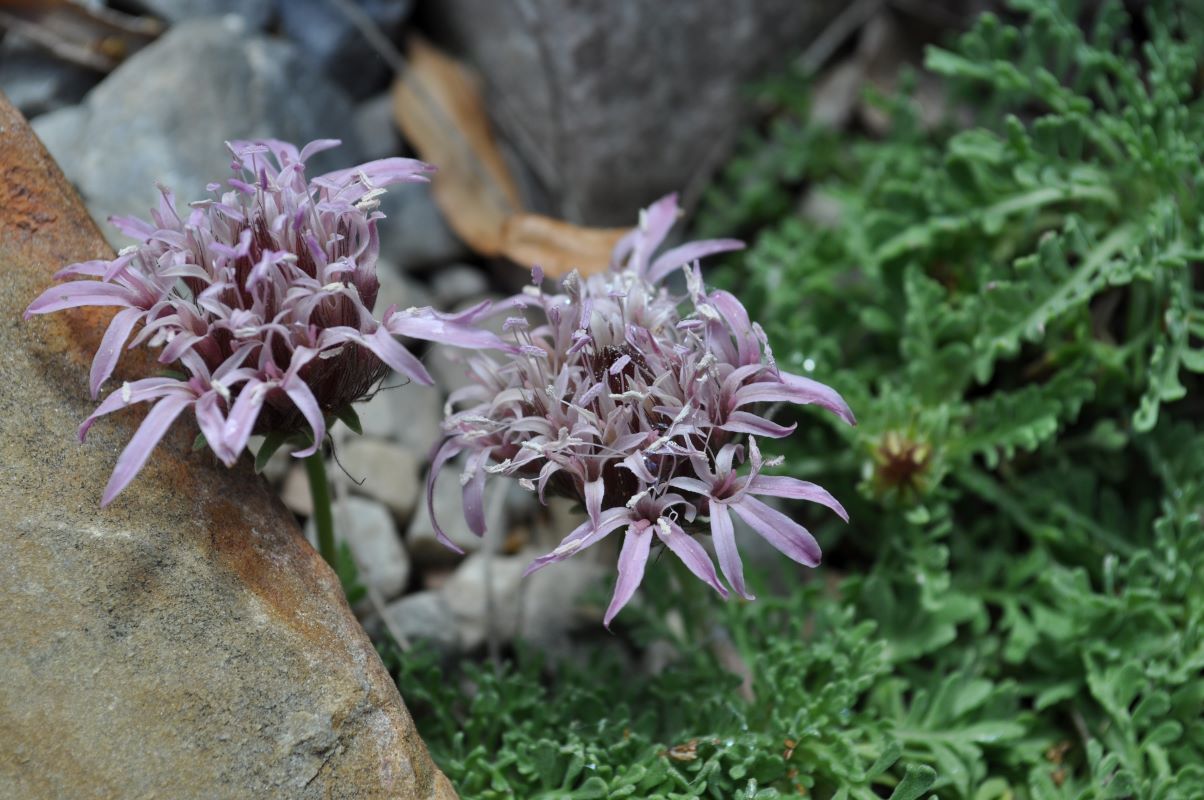
Moroccan Pincushion Flower Pterocephalus depressus
A remarkably tough and beautiful groundcover of gray-green crinkled leaves. It can tolerate light foot traffic. This textured mat offers something stunning all four seasons. Large mauve-pink flowers adorn the tiny, lacy evergreen foliage from late spring through the summer. Flowers transition to silvery seed heads in the fall and the foliage can be enjoyed year-round.
-
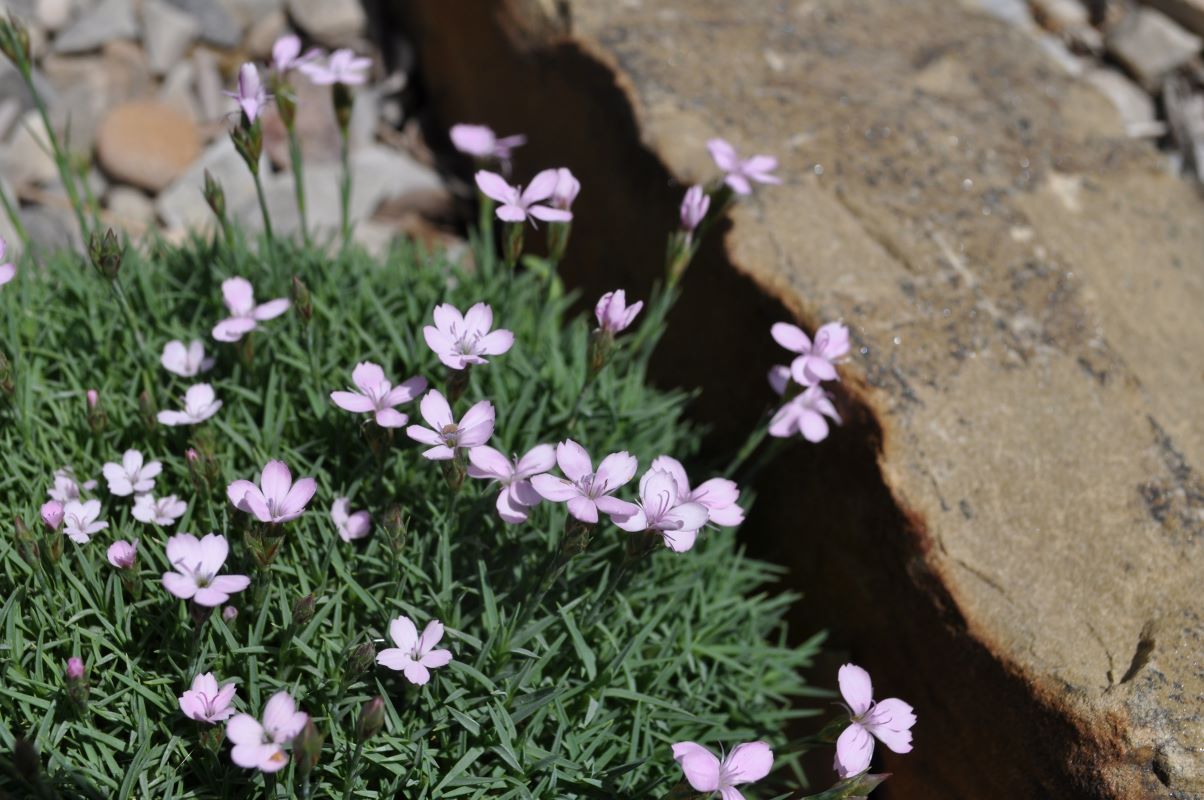
Mossy Sandwort Arenaria 'Wallowa Mountain'
This drought tolerant perennial forms a dense layer of evergreen foliage. It’s small stature and fine details make it perfect for crevice gardens, filling in between stones and complimenting cacti/succulents. Although it is used mainly for its foliage, attractive, tiny white to light pink blossoms appear sporadically in late spring to early summer.
-
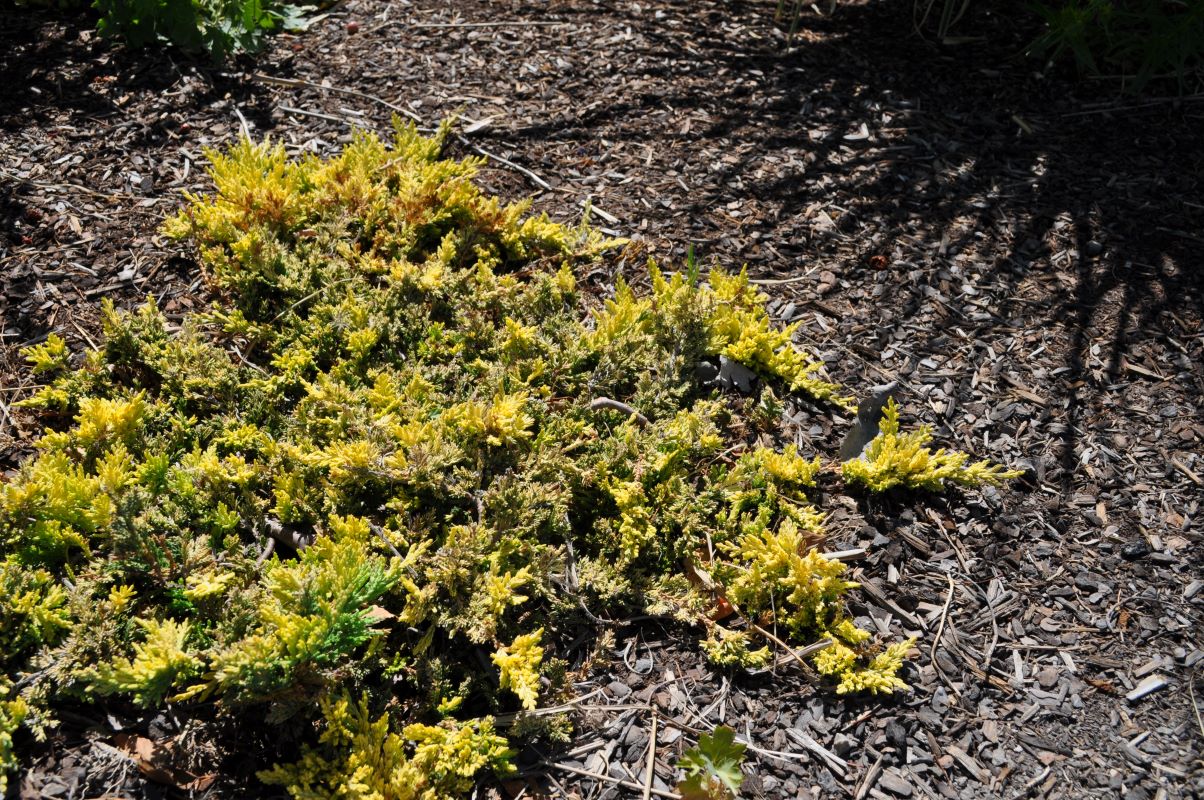
Mother Lode Creeping Juniper Juniperus horizontalis 'Mother Lode'
This groundcover offers interest in the landscape with its gold, soft and feathery foliage. Staying low to the ground, the creeping branches root down as they spread. The foliage turns a golden bronze to plum color in the winter.
-
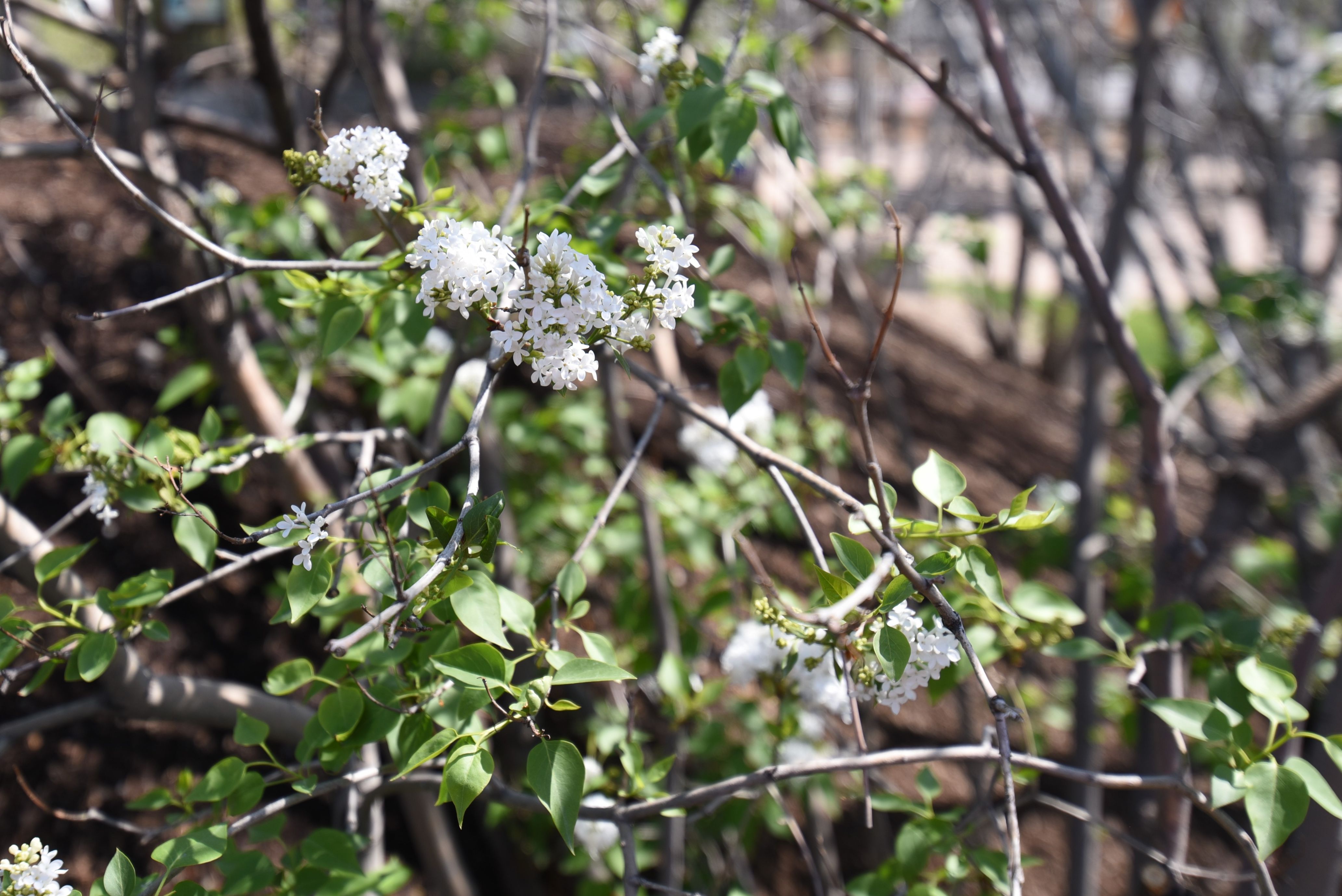
Mount Baker Lilac Syringa x hyacinthiflora 'Mount Baker'
Large deciduous flowering shrubs. Profuse white fragrant flowers are borne on terminal panicles. Named after the snow covered peaks of Washington state's Mt. Baker. Lance shaped dark green leaves provide a beautiful back drop to the flowers. This variety blooms 2 weeks earlier than other lilac species. Once established, it can withstand much drought but prefers moderate amounts of water. Tolerates many soil types and conditions.
-
Mount Everest Ornamental Onion Allium stipitatum 'Mount Everest'
Bulbous ornamental perennial onion. Forms light green strap-like basal leaves up to 3 feet long. Bears dense umbels of about 50 star-shaped white flowers. Plant bulbs 9-12 inches apart in clumps for the best effect.
-
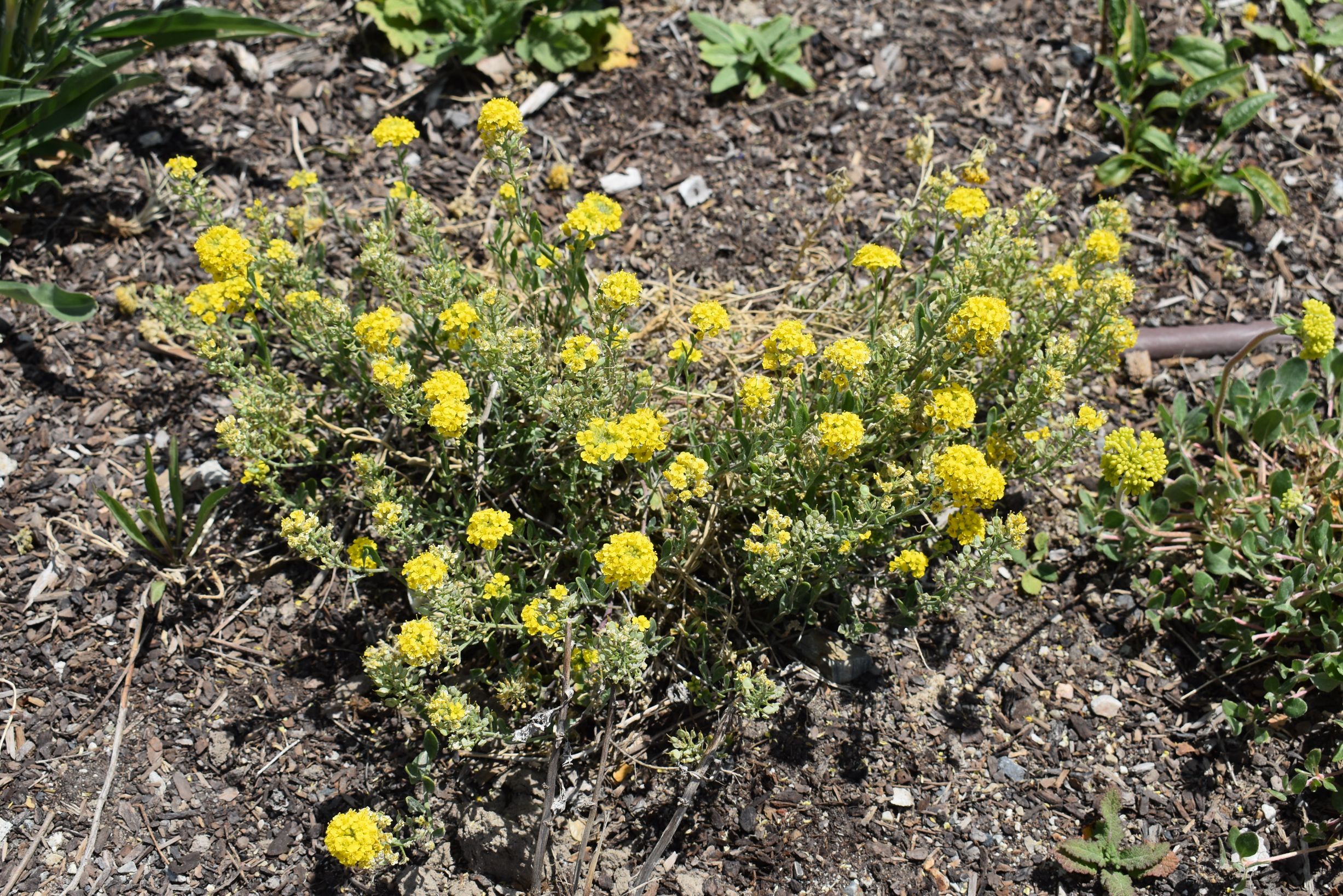
Mountain Alyssum Alyssum montanum 'Luna'
This is a rock garden perennial that blooms in the spring. It forms a low trailing mound of grey-green leaves with a mass of bright yellow flowers from late spring and into the fall. This plant does not divide easily. It is drought tolerant once established.
-
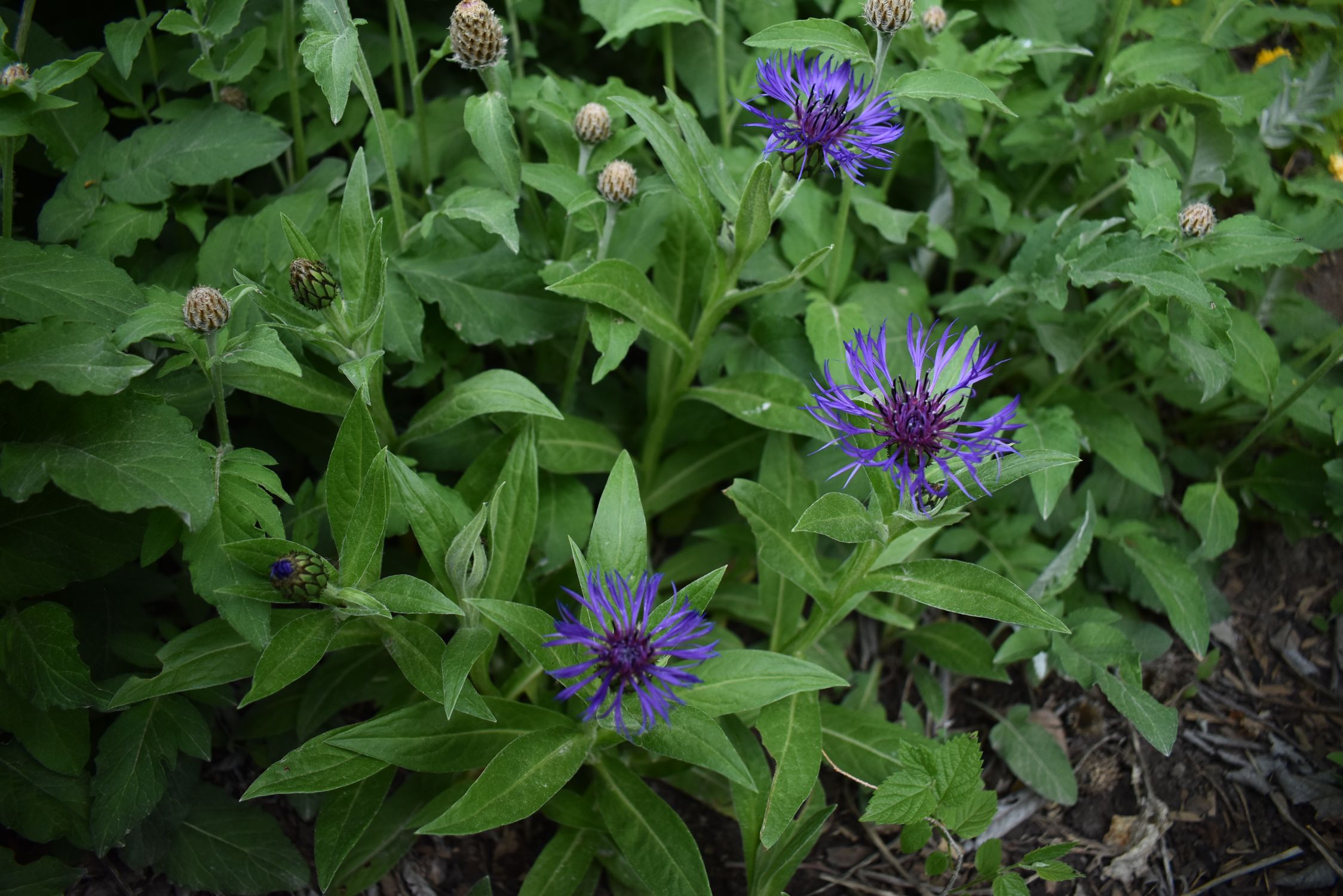
Mountain Cornflower Centaurea montana
Clump-forming herbaceous perennial with blue daisy-like flowers with pruplish centers. Mid to dark-green lance-shaped leaves grow on upright, unbranching stems. Spreads readily by stolons, allow room to grow. Tolerant of many soil types and drought. Does not tolerate water-logged soils.
-

Mountain Flame Fire Chalice Epilobium (syn Zauschneria) latifolia 'Mountain Flame'
A mounding perennial that enjoys full sun or partial shade. Lighter green, long oval leaves sporadically cover long slender stems. The stems are wispy and free flowing, creating a more open habit and shape. Midsummer brings beautiful, bright blood orange tubular blossoms that provide color till frost.
-
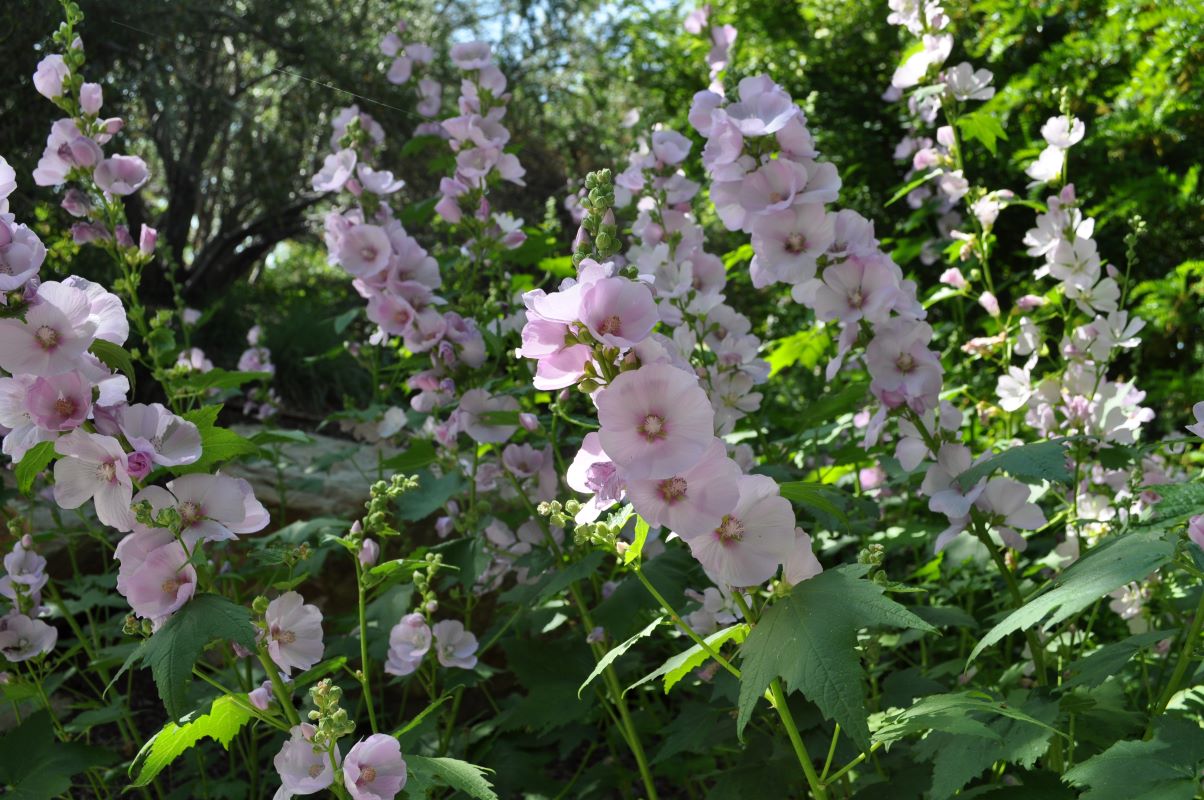
Mountain Hollyhock Iliamna rivularis
A native wild hollyhock found largely along streambanks, on forested slopes, and in disturbed areas. It flowers profusely following heat treatments such as wildfires. Tall spikes are covered with large showy white to pink blooms. Leaves are large and broadly heart shaped.
-
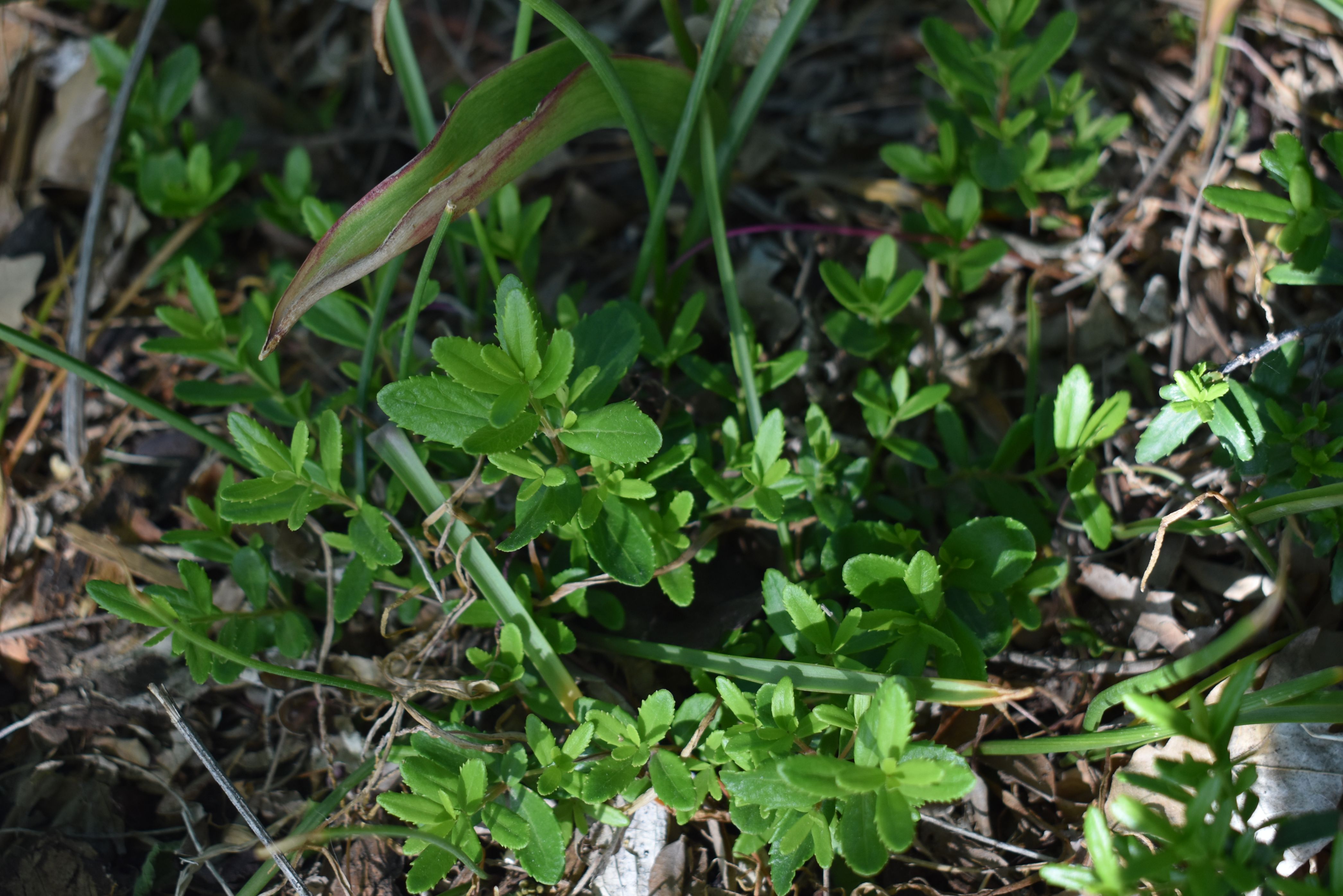
Mountain Lover Paxistima myrsinites
Native, low-growing broadleaf evergreen shrub also known as Oregon Boxwood. Has a tidy, compact growth habit and makes a good groundcover if planted close together. Thick, dark green leaves will burn in the winter if planted in a site that is too exposed. This shrub grows naturally as an understory plant, making it a great choice for dry shaded areas.
-

Mountain Mint Pycnanthemum muticum
This fragrant mint is native to North America. Unlike other mints, this one is well-behaved and doesn't spread. It has many herbal uses including medicinal and can be used in teas and for herbal treatments. Pink flowers with white bracts are pleasant rather than showy.
-

Mountain Rush Juncus arcticus ssp. littoralis
This native wetland perennial is grass-like with wiry leaves growing in clumps. It is not considered waterwise as it grows naturally in wetland or boggy areas. At Conservation Garden Park, it grows naturally in wetland areas near the stream and in bioswales that are consistently wet due to drainage.
-

Mountain Sandwort Arenaria montana 'Avalanche'
Grey-green leaves create a low, evergreen cushion that produces large white flowers. A great plant for edging walkways, filling in crevice gardens and putting between flagstones.
-
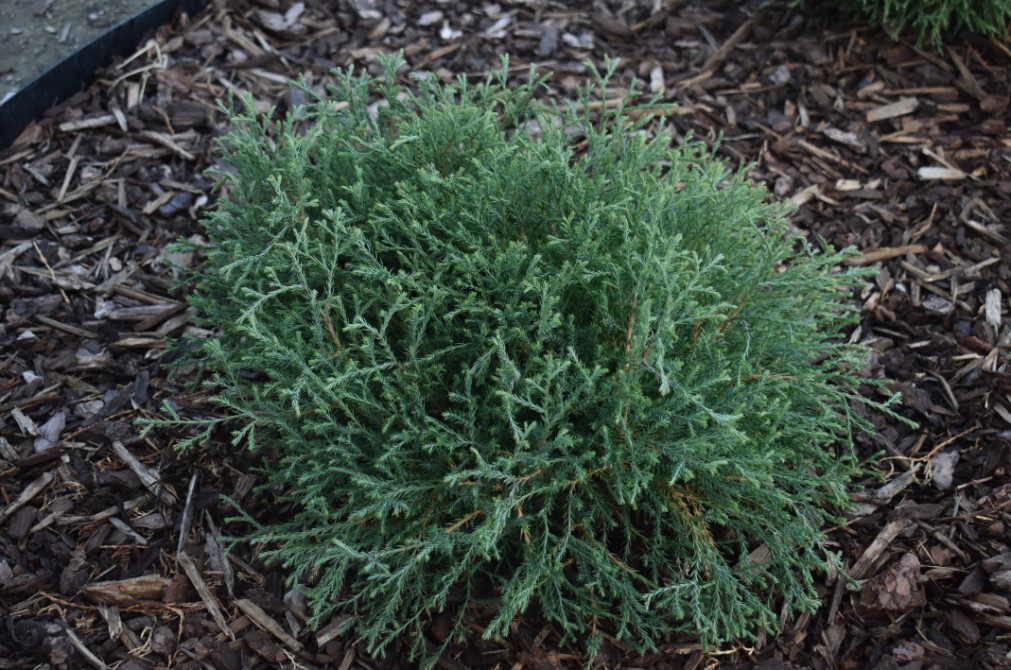
Mr Bowling Ball Arborvitae Thuja occidentalis 'Bobozam'
This is a dwarf evergreen shrub with thick foliage and a dense, round shape, giving it it’s name of bowling ball. The foliage maintains its color throughout the year providing great winter interest. This is great when used as a foundation plant, in small areas, and as a low growing hedge.
-
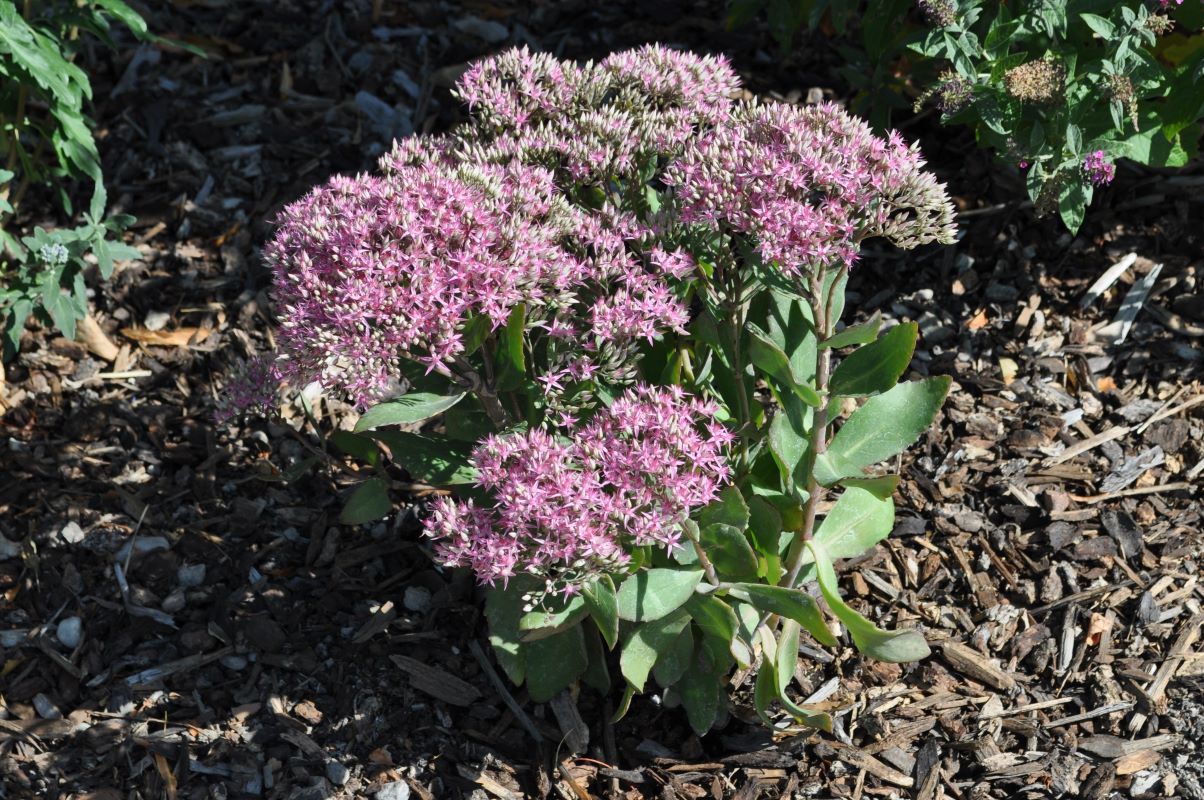
Mr Goodbud Stonecrop Sedum 'Mr. Goodbud'
This Stonecrop is upright and clumping in habit. The foliage is green with a slight tint of silver-blue that contrasts beautifully with the magenta blossoms. The late summer into early fall brings dense heads of light purple buds that blossom into vivid hot-pink flowers. The leaves turn a soft red as the temperatures become cooler.
-

Mrs Robb's Bonnet Euphorbia amygdaloides var. robbiae
This wood spurge is a clump-forming evergreen perennial that works well in shade. Its glossy, dark-green leaves are close set and attractive, even in the winter. Yellow bracts back small chartreuse flowers in the spring. Well adapted to Utah's climate and should tolerate some heat and drought.
-
Mugo Pine Pinus mugo
Medium to large rounded to spreading evergreen shrub. Spreading branches are scaly and gray. Dark green needles are born in pairs and grow to 1.25 to 3 inches long. Bears dark brown female cones. May require some pruning to shape, simply prune the new growth or "candles." Tolerant of many soil types. Needs well drained soils and fairly drought tolerant.
-

Munchkin Oakleaf Hydrangea Hydrangea quercifolia 'Munchkin'
Deciduous shrub. Upright, broad-rounded, suckering, multi-stemmed habit. It blossoms in early summer with panicles of white flowers that fade to pink and then brown as summer progresses. The leaves are deeply lobed, resembling oak leaves. Autumn brings red and orange hues to its foliage. It grows best in organic soils with moderate moisture.
-
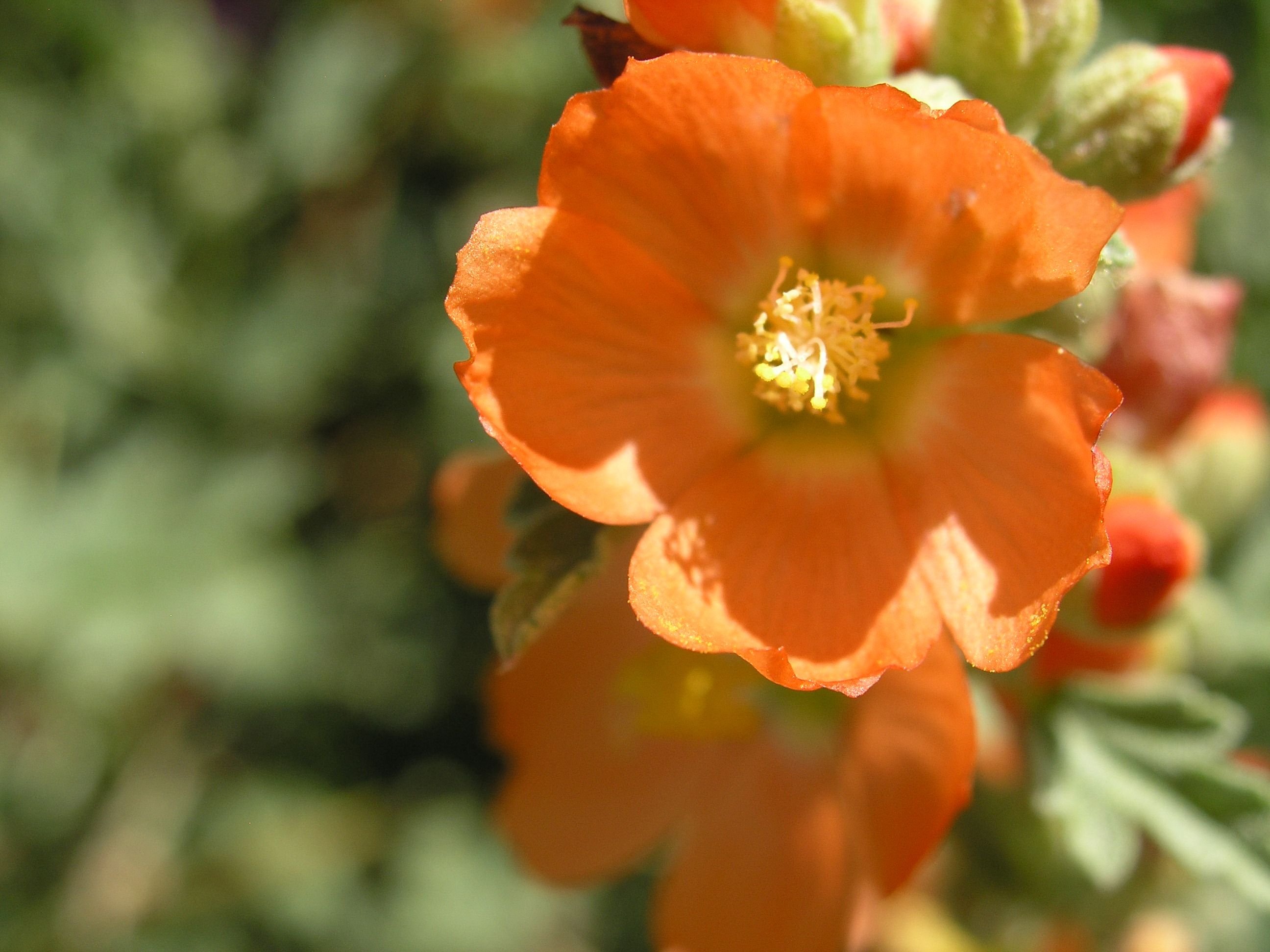
Munroe Globemallow Sphaeralcea munroana
Taprooted branching perennial native to the western United States. Gray-green ovate leaves are lobed and irregularly toothed. Brilliant orange flowers adorn this plant throughout the summer. Grows naturally in hot and dry locations. Will not tolerate overwatering. Excellent choice for any water-wise landscape.
-
Munstead Lavender Lavandula angustifolia 'Munstead'
Dense, bushy, low-growing perennial. Native to the mediterranean region of southern Europe. Linear gray-green leaves are very fragrant, especially when bruised. Fragrant blue flowers are formed on tall stalks above the plant. Lavender is used herbally and medicinally for various purposes. Requires well-drained soils and is very drought tolerant.
-
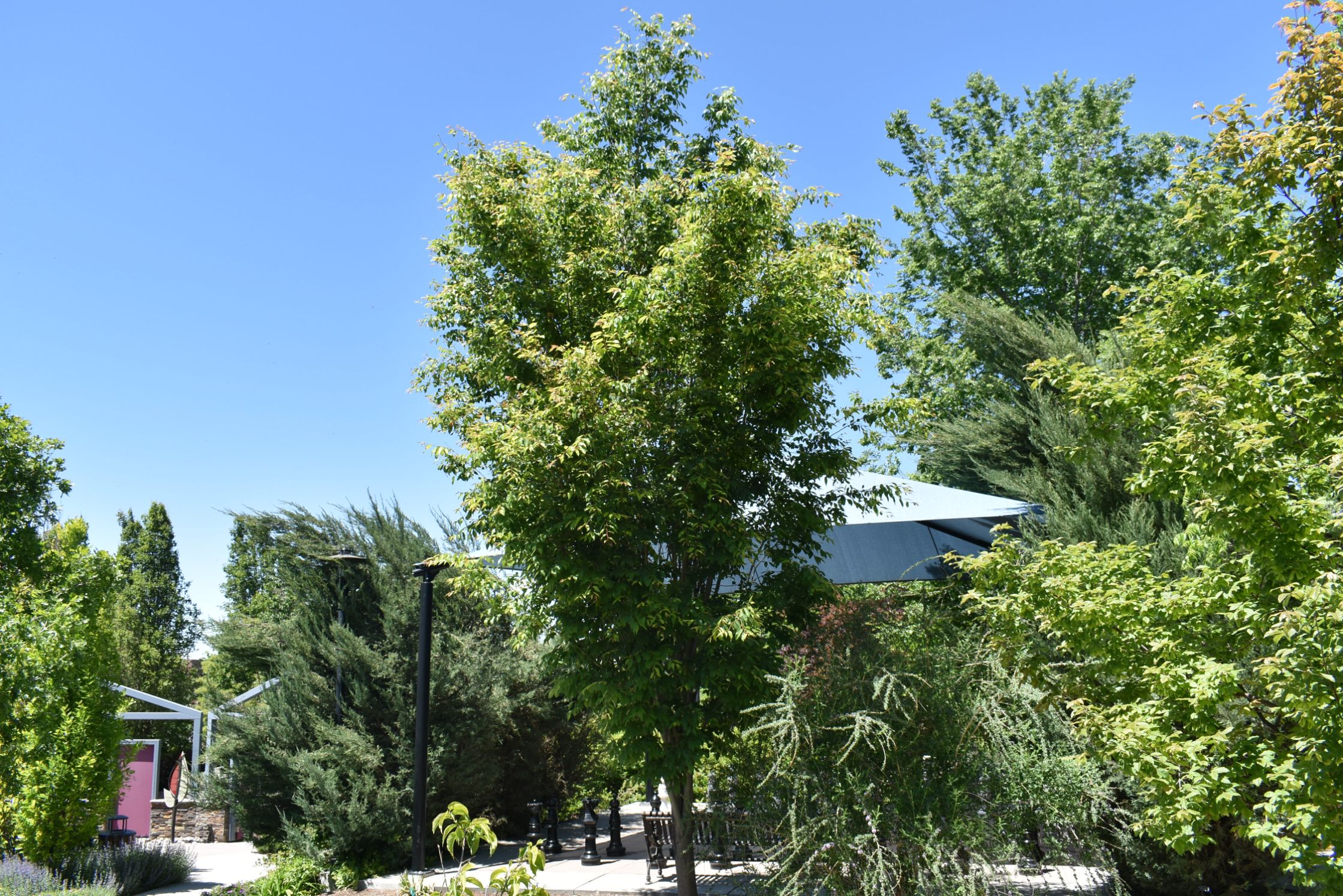
Musashino Columnar Zelkova Zelkova serrata ‘Musashino’
A tightly columnar, vase-shaped tree ideal for narrow or confined spaces. A good choice for wind and/or privacy screen. Small, serrated leaves turn a rusty-yellow in fall. Fast growing, tall and slender, Musashino offers a strong visual element to the landscape. Very adaptable to a variety of soils and pollution.
-
MaacNificent Amur Maackia
A vigorous-growing Maackia with an elegant vase shape. Leaves composed of multiple leaflets emerge silvery green in the spring, turn a more solid green in summer, then turn yellow in the fall. Reddish-bronze bark exfoliates on older specimens. Tall spikes of dull white flowers turn to flat seed pods. Tolerant of acidic and slightly alkaline soils.
Maackia amurensis 'JFS-Schichtel1'
Mature Size: 20-30' tall x 20-35' wide
-

Madame Galen Trumpetvine
Vigorous woody climbing vine with green leaves and orange/red tumpet-shaped flowers that bloom from late summer into fall. This variety is one of the hardiest and most reliable to grow in most soils. Attracts hummingbirds and some insects. Requires no additional moisture once established.
Campsis x tagliabuana 'Madame Galen'
Mature Size: 15-25' tall x 6-12' wide
-

Magic Carpet Japanese Spirea
Small, rounded deciduous shrub. Produces abundant flat clusters or rose pink flowers in mid to late spring into the summer. Young leaves emerge reddish bronze. Depending on the amount of shade Walbuma is in, mature leaves will range from golden yellow to bright green. Requires significant pruning to promote more flowering.
Spiraea japonica 'Walbuma'
Mature Size: 18-24" tall x 24-36" wide
-
Magnus Coneflower
Very hardy upright-growing perennial. This variety has large, magenta daisy-like flowers up to 7" across with dark orange centers. Will tolerate some drought once established. Deadheading will prolong the flowering time. Great choice as a specimen or in masses. Looks great in meadows or prairies.
Echinacea purpurea 'Magnus'
Mature Size: 2-3' tall x 1.5' wide
-
Majestic Beauty Tulip Tree
Golden edged lobed leaves adorn this large deciduous tree. Spring brings tulip shaped orange flowers. It prefers adequate water and acidic soils but may adapt to drier soils once established.
Liriodendron tulipifera 'Aureomarginatum'
Mature Size: 40-60' tall x 15-25' wide
-

Major Wheeler Honeysuckle
The most profuse bloomer of the honeysuckle vines, 'Major Wheeler' puts on a display of bright red flowers in spring. Hummingbirds love the tubular flowers and will be seen visiting. It grows fast over trellises and is easy to care for.
Lonicera sempervirens 'Major Wheeler'
Mature Size: 8-15' tall x 3-6 wide
-

Majorican Germander
This is an awesome evergreen groundcover with thin, silvery gray leaves. The flowers and leaves are very fragrant. With pink-purple flowers, this plant can have a similar look to lavender. It grows well in full sun and likes hot, dry areas with good drainage. Sometimes labelled as Teucrium aroanium 'Majoricum' or Gray Creeping Germander.
Teucrium cossonii subsp. majoricum
Mature Size: 2-3" tall x 18-24" wide
-

Male Hardy Kiwi Vine
This is a deciduous, fast-growing twining vine that has deep green leaves. The leaves of this woody vine are sharply toothed. The male Kiwi vine does not produce fruit but is used as a pollinator for other female Kiwi vines. It is an aggressive vine requiring support.
Actinidia arguta
Mature Size: 12-20' tall x 3-5' wide
-
Mallow Ninebark
This Ninebark is loved for its flaky cinnamon colored bark, attractive green foliage and delicate white blossoms that cover the shrub in spring and early summer. The fruit that follows the flowers are inconspicuous.
Physocarpus malvaceous
Mature Size: 3-6' tall and wide
-

Maltese Cross
Upright, stiff perennial that grows best in full sun. Bright orange-red flowers are formed in dense clusters atop 3-4 foot tall stalks with mid-green foliage. Individual flowers are 3-4" in diameter. Has a short bloom season from early summer to mid summer.
Lychnis chalcedonica
Mature Size: 2-4' tall x 1' wide
-

Mango Lassi Avens
An evergreen perennial that produces abundant flowers from late-spring into fall. Double petals appear in multi-colored hues of oranges, reds and yellows. The foliages is dark-green with scalloped edges. Prefers to grow with moderate amounts of water.
Geum 'Mango Lassi'
Mature Size: 4-16" tall x 12-24" wide
-

Mango Popsicle Dwarf Poker
This amazing drought tolerant plant has great color and texture throughout the growing season. A tidy clump of narrow green foliage produces a continuous bloom of tall orange spikes throughout summer and into fall. The saturated mango-colored flowers attract hummingbirds.
Kniphofia 'Mango Popsicle'
Mature Size: 18-30" tall x 12-18" wide
-
Marcus Meadow Sage
This is a very compact selection of meadow sage making it a great plant for any border. It has spikes of intense violet flowers over a grey-green shrub-like clump of fragrant foliage throughout the summer. This perennial can be planted in mass for a dramatic show.
Salvia nemorosa 'Marcus'
Mature Size: 12-18" tall and wide
-
Margarita BOP Penstemon
Semi-evergreen mound-forming perennial with short spikes of long-blooming lavender to magenta flowers. Short linear leaves grow on upright reddish stems. This cross between P. heterophyllus and P. laetus was originally found by Las Pilitas nursery at the Bottom Of the Porch, hence the BOP in the name. Tolerates drought and requires well-drained soils.
Penstemon heterophyllus 'Margarita BOP'
Mature Size: 18" tall x 18-30" wide
-

Marian Sampson Monardella
Native to California, this perennial is hardy in the Salt Lake Valley. Scarlet red trumpet-shaped flowers grow in prolific clusters that are very attractive to hummingbirds and butterflies. Small dark green leaves look good in rock gardens. It is difficult to establish, so expect to lose some.
Monardella macrantha 'Marian Sampson'
Mature Size: 3-4" tall x 6-8" wide
-

Marie Lemoine Peony
Clump-forming, shrubby, herbaceous flowering perennial. Large double creamy white flower is sweetly fragrant and blooms in late-spring. Deeply lobed glossy green foliage provides appeal even when not in bloom. Makes a superior cut flower. Plant in fertile, well-drained soil. Tolerates some drought once established.
Paeonia lactiflora 'Marie Lemoine'
Mature Size: 2-3' tall and wide
-
Marilee Crabapple
This crabapple is narrow and upright in habit. It has a lighter green foliage with double, large white flowers that start off as pink buds. The tree is nearly fruitless and is a good option for streetscapes and utility line areas.
Malus 'Jarmin'
Mature Size: 10-25' tall x 10' wide
-

Matrona Stonecrop
Vase-shaped, upright growing succulent perennial. Flattened clusters of numerous star-shaped pink flowers bloom in late summer to fall. Purplish stems and succulent gray-green leaves tinged bronze provide year round appeal. Tolerates poor soils and drought.
Sedum 'Matrona'
Mature Size: 18-24" tall x 12-18" wide
-

May Night Sage
Upright clump-forming perennial with long-blooming deep-blue flowers starting in early summer. Mid to dark green foliage grows on upright stems which will flop over after blooming. These old stems can be cut back nearly to the ground to promote reblooming. Plant in well-drained soil and do not overwater.
Salvia x sylvestris 'Mainacht'
Mature Size: 18-28" tall x 12-18" wide
-
McKana Hybrid Columbine
One of the best know varieties of columbine. Bears multi-colored flowers in spring, ranging from pastel shades of blues, reds, and yellows. Attractive green fern-like foliage adds beauty to the garden during the rest of the year. Developed from a mix of North American species.
Aquilegia (McKana Group)
Mature Size: 24-36" tall x 12-18" wide
-
McKay's White Shrubby Cinquefoil
Very adaptable shrub with irregular growth. Lush compact growth and mid to dark green foliage are very attractive. Creamy white flowers appear in summer and last until fall. Great choice for providing lushness to a difficult landscape. Regular pruning of dead branches will keep this shrub looking nice. Recently moved to the genus Dasiphora but still more commonly referred to as Potentilla.
Potentilla fruticosa 'McKay's White'
Mature Size: 2-4' tall and wide
-

Meadow Blazing Star
A wild-looking perennial that offers delicious nectar for many pollinators, especially Monarch butterflies. Tall slender stems are covered in tiny, vibrant purple, thistle-like blossoms in the later parts of summer, offering a perfect stop for the Monarchs on their migration south. The flower stalks stand tall and erect, making them a beautiful vertical addition to planting beds. In ideal conditions it can grow up to 5’, but typically it will stay closer to 3’.
Liatris ligulistylis
Mature Size: 12-36" tall x 6-24" wide
-

Merrill Magnolia
Small deciduous flowering tree. Produces large, 15 petaled, white fragrant flowers in spring, which bloom prior to the emergence of leaves. Has dark green summer foliage turning to yellow in fall. Prefers fertile soils and moderate waterings. Plant in an area to showcase the spring blossoms.
Magnolia x loebneri 'Merrill'
Mature Size: 12-25' tall x 10-25' wide
-

Mesa Verde Hardy Ice Plant
This freely branching, mat forming ice plant has jellybean shaped foliage that may become flushed with purple in the winter. From May until fall beautiful salmon-pink blossoms with yellow centers densely cover the fleshy foliage.
Delosperma 'Kelaidis'
Mature Size: 3-6" tall x 12-24" wide
-

Mesa Verde Spruce
A compact variety of Blue Spruce with sharp pointed four sided, green needles 1/2" to 1 1/2" long, arranged radially on the shoots. This variety is usually greener than the rest of the species. Noted for its exceptional tolerance for poor soils and difficult sites.
Picea pungens 'Mesa Verde'
Mature Size: 2-3' tall x 4-6' wide
-
Mexican Feather Grass
This ornamental grass will provide beautiful movement and energy in the landscape with its hair like, extremely fine and flowing light green foliage. A cool-season grass that can hold onto its color for much of the year (may brown as temperatures are at their highest in the summer). Late spring into the early summer brings wispy, wheat colored seed heads that highlight the swaying foliage below. Mexican Feather Grass is self-seeding so plant in an area where it is desired for it to spread or where it can be easily controlled.
Nassella tenuissima
Mature Size: 24-36" tall x 20-24" wide
-

Mexican Hat
A fun, fast growing daisy-like flower that requires no water once established. Long-blooming flowers may be fully yellow or dark burgundy with yellow edges. The hat-shaped flowers have green-to-brown cone-shaped centers with petals hanging from the bottom edge, similar to the closely related Black-eyed Susan. It blooms best in full sun but otherwise tolerates a range of environments.
Ratibida columnifera
Mature Size: 12-36" tall x 12-18" wide
-

Midnight Marvel Hardy Hibiscus
A large, summer blooming shrubby perennial that has large, tropical looking, deep red flowers. The flowers appear in mid-summer and continue until frost. The leaves are maple shaped and burgundy. It works best in full sun, but will tolerate some light shade.
Hibiscus moscheutos 'Midnight Marvel'
Mature Size: 3-4' tall and wide
-
Midnight Model Meadow Sage
Large, leathery leaves hold up tall spikes of vibrant blue-purple blossoms. Flowers attract butterflies, hummingbirds and bees and are good for cut flowers. Midnight Model will perform at its best in full sun.
Salvia pratensis 'Midnight Model'
Mature Size: 20-24" tall and wide
-
Midwinter Fire Dogwood
An upright deciduous shrub with orange-yellow to red winter shoots and mid-green leaves 4" long, turning golden yellow to red in autumn. From May-June, bears white flowers in clusters up to 2" across followed by dull blue-black fruit. Fruit is not showy, but is attractive to birds. Prefers full sun and well drained, moist soil.
Cornus sanguinea 'Midwinter Fire'
Mature Size: 5-6' tall x 6' wide
-

Millenium Ornamental Onion
Millennium is a great ornamental onion. Blooming in mid-summer the large globe rose-pink flowers make a striking appearance. Foliage grows from the base, green and grass-like. Attracts bees and butterflies and is fragrant.
Allium 'Millenium'
Mature Size: 12-15" tall x 18-22" wide
-

Millstone Japanese Pagodatree
Deciduous tree with rounded to oval form. Lustrous green leaves are composed of multiple leaflets. Leaves turn bright yellow in the fall. Creamy-white blooms are formed in the summer and forming seed pods in late-summer. Tolerates many soil types and conditions. Less susceptible to stem canker than the species.
Sophora japonica 'Halka'
Mature Size: 45' tall x 35' wide
-
Mimosa
A small, showy, fast-growing deciduous tree. Branches spread out forming a domed crown. Bipinnately compound mid to dark green leaves are fern-like. Fluffy pink flower heads bloom throughout the summer eventually turning to long seed pods. Very tolerant of many soil types and very resistant to drought but will grow better with sufficient irrigation. Susceptible to many diseases. Average life-span is 10-20 years. Known to be very invasive in many areas of the United States. Not known to be invasive in Utah, but plant with care.
Albizia julibrissin
Mature Size: 15-25' tall x 25-35' wide
-

Minerva Rose of Sharon
Vigorous, multi-stemmed, upright, deciduous flowering shrub. Numerous showy, lavender-pink, 5-petaled flowers with dark red eyes are borne throughout the summer. Attractive 3-lobed, coarsely toothed leaves grow on erect stems. Tolerant of heat, drought, and poor soils. Prefers fertile soils with moderate amounts of water.
Hibiscus syriacus 'Minerva'
Mature Size: 6-10' tall x 4-8' wide
-
Mini Man Dwarf Manchurian Viburnum
‘Mini Man’ brings a compact stature to the multi-season appeal of the Manchurian Viburnum, with clusters of bright white flowers in the spring, thick, textured leaves in the summer, red-black fruit that stays on the plant, and red foliage in the fall. A native of Russia, this low-maintenance shrub can handle extreme cold and a variety of soil types.
Viburnum burejaeticum 'P017S'
Mature Size: 4-6' tall and wide
-

Miniature Mat Daisy
A shade loving groundcover that offers a thick mat of small, spoon-shaped leaves. Daisy-like white blooms with yellow centers cover the plant from late spring through the summer. It can handle moderate foot traffic.
Bellium minutum
Mature Size: 1-4" tall x 15" wide
-

Minnesota Snowflake Mock Orange
Multi-stemmed deciduous shrub with upright arching brances. Profuse white flowers are double and very fragrant. Blooms begin in late spring and last up to 4 weeks. Tolerates some shade but produces more flowers in full sun. Requires low to moderate amounts of water. Adaptable to many soil types.
Philadelphus x virginalis 'Minnesota Snowflake'
Mature Size: 6-8' tall and wide
-

Miracle Coral Bells
A clump-forming coral bell that is appreciated for its color changing foliage. Springtime leaves emerge in a bright chartreuse color with red accents. As summer approaches they mature to a brick red edged in chartreuse and golden yellows. In early summer, dainty, light pink blossoms sit atop long, slender stems that rise high above the colorful foliage.
Heuchera villosa 'Miracle'
Mature Size: 10-18" tall x 10-12" wide
-
Miss Kim Lilac
A compact, bushy, deciduous shrub with terminal panicles of lavender to light blue fragrant flowers that bloom in spring. Lance shaped glossy green leaves turn burgundy in autumn. Prefers moderate amounts of water in well drained soils. Best flowering occurs in full sun.
Syringa pubescens ssp. patula 'Miss Kim'
Mature Size: 4-9' tall x 5-7' wide
-

Miss Manners Obedient Plant
A well-behaved North American wildflower that forms a clean, compact clump. It is non-spreading and produces white snapdragon-like blooms that make a nice cut flower. This cultivar is less prone to flopping.
Physostegia virginiana 'Miss Manners'
Mature Size: 2-2.5' tall and wide
-

Miss Molly Butterfly Bush
Compact, fragrant deciduous shrub. Pink-red flowers attract butterflies and hummingbirds in the summer. Flowers bloom in clusters and can be deadheaded for a cleaner look.
Buddleja 'Miss Molly'
Mature Size: 4-5' tall and wide
-

Miss Piggy Heartleaf Bergenia
Large clusters of bubblegum-pink flowers bloom earlier in spring than most perennials. Mounds of broad, glossy, dark green leaves stay green through the winter. Looks great planted in groups under trees and tall shrubs.
Bergenia cordifolia 'Miss Piggy'
Mature Size: 16-18" tall x 28-32" wide
-
Missouri Evening Primrose
A vigorous perennial with trailing, hairy, often red-tinted stems branching from a central root. Large bright yellow blossoms open up to 4" in diameter in the early evening. Useful as a ground cover. Prolific self seeder and if conditions are right, may become somewhat invasive and require control.
Oenothera macrocarpa
Mature Size: 6-12" tall x 18-24" wide
-

Missouri Iris
A variable, beardless iris with narrow leaves to 20 inches, overtopping the flowers. Each branched stem bears 2-4 flowers 2.5-3 in. across. Blossoms are pale to deep blue or lilac/purple having larger falls with deep purple veining. Blooms from May-June. Best grown in full sun and well drained, slightly acidic soil.
Iris missouriensis
Mature Size: 12-24" tall x 8-12" wide
-

Mitsch Weeping Scots Pine
Contorted, weeping, finely textured branches full of green needles—all the reasons why this Scots Pine is a beautiful centerpiece in the landscape. Whatever height it is staked at, the long arching branches will flow to the ground creating movement and interest.
Pinus sylvestris 'Mitsch Weeping'
Mature Size: 3-10' tall x 5-10' wide
-

Mohave Lotus
Wiry stemmed, shrubby perennial native to southwestern United States and northwestern Mexico. Stunning bright yellow flowers tinged with red and orange bloom from early to mid-spring turning to slender pods in summer. Green palmate or pinnate leaves grow sparsely on long thin stems. May not be readily available for sale. Grows well in hot dry locations.
Lotus rigidus
Mature Size: 1-3' tall and wide
-

Mojave Sage
Small, low-maintenance evergreen shrub with silvery-green foliage provides interest throughout the year. Clusters of tall fuchsia-purple flowers bloom continuously throughout the summer. Resistant to mammal browsing due to its pungency. Plant in well-drained soils. Does best in sunny, hot locations.
Salvia pachyphylla
Mature Size: 2-3' tall and wide
-

Monch Aster
This free flowering compact perennial has many large, long-lasting flowers with slender lavender-blue petals in summer to early autumn. Oblong leaves are green. Generally resistant to disease. Avoid overwatering and wet winter soils.
Aster x frikartii 'Mönch'
Mature Size: 18-36" tall x 12-18" wide
-

Mongolian Bells Clematis
A compact variety of clematis. It does not need staking and is well suited for edgings and borders. Bell shaped blooms of pink, white, lavender and blue appear in May and continue until September. The plant can be cut back to the ground after the first flush of blooms to encourage upright growth or it can be left to form attractive seed heads in the fall.
Clematis integrifolia 'PsHarlan'
Mature Size: 10-18" tall x 12-16" wide
-
Montgomery Blue Spruce
An evergreen shrub that stays compact and round when young. As it matures (and if left unpruned) it can become a more squat conical shape tree with dense branching. It does grow slowly. Blue-grey needles are short and quite sharp. Great choice for accent planting and to provide winter interest in small areas. Requires plenty of water during establishment period to ensure proper root development. Becomes more drought tolerant with age.
Picea pungens 'Montgomery'
Mature Size: 6-8' tall x 3-6' wide
-
Moonbeam Coreopsis
Has graceful, airy, fern-like foliage with tiny light to lemon yellow daisy-like flowers and darker yellow centers. The blossoms begin in early summer and can last well into the fall. One of the most drought tolerant of its varieties. Great for perennial yards or for containers. Requires full sun and dry to medium-moist soils.
Coreopsis verticillata 'Moonbeam'
Mature Size: 18-24" tall x 48" wide
-

Moongold Apricot
Small, deciduous, fruit bearing tree. Flowers bloom white in spring becoming small peach-like fruits that ripen in late-July. Apricots tend to be very adaptable to dry conditions. Fruit is best when moderate water is provided and when they are properly maintained.
Prunus armeniaca 'Moongold'
Mature Size: 15-30' tall x 10-20' wide
-
Moonlight Scotch Broom
This deciduous shrub is made up of extremely slender stems that are covered with tiny, bright green leaves. Large, pale-yellow blooms appear in late-spring and early-summer turning to black pods later in the year. Native to western Europe but adaptable to dry conditions.
Cytisus scoparius subsp. maritimus 'Moonlight'
Mature Size: 4-6' tall and wide
-
Moonshine Yarrow
Upright growing herbaceous perennial with fern-like foliage and flat-topped flower clusters. Small bright-yellow blooms begin flowering in early-summer and continue until the fall. Gray-green aromatic foliage is unappetizing to deer. Grows well in many soils and with low amounts of water. Clumps will spread but not uncontrollably.
Achillea 'Moonshine'
Mature Size: 12-24" tall x 10-12" wide
-
Moonstone Red-Hot Poker
This perennial has fleshy grass-like leaves that grow in a clump. Tubular, yellow to ivory flowers grow in clusters on top of long stems. The leaves are mid-green and not too showy, but are easy to maintain when not flowering. Red hot pokers are robust plants that require some water but will handle drought.
Kniphofia 'Moonstone'
Mature Size: 24-30" tall x 18" wide
-
Moonswirl Coreopsis
The semi-double flowers of this tickseed cultivar resemble marigolds, with layers of ruffly, yolk-yellow petals. This exceptionally long-blooming perennial will bring a pop of color even to hot, dry spots and will spread and naturalize under ideal conditions.
Coreopsis grandiflora 'Moonswirl'
Mature Size: 15-18" tall x 12-14" wide
-
Mops Mugo Pine
This dwarf variety of mugo pine has a dense rounded form that grows no taller than 3-4 feet. It is a slow grower and will take many years to reach its maximum height. The mid to dark green needles are 1-2" long and grow in bundles of two. It tolerates many soil types and does best with moderate water.
Pinus mugo 'Mops'
Mature Size: 3-4' tall x 2-3' wide
-

Mora County Mix Chocolate Flower
Add the scent of chocolate to your garden with this cheerful, long-blooming perennial. Bright yellow flowers open in the mornings from spring through late summer and then close with the heat of the day. This variety is hardier than the species and can handle colder climates. It is adaptable to heavy soils and does not require additional water once established. The seeds provide food for birds.
Berlandiera lyrata 'Mora County Mix'
Mature Size: 12-15" tall x 18-24" wide
-

Mormon Tea
Leafless evergreen shrub with bright green wiry stems. Stems are finely furrowed and jointed growing in broom-like structures. Flowers are inconspicuous. Allegedly used by Mormon pioneers to make a medicinal tea. Very drought tolerant. Needs no additional water but requires well-drained soils. Survives in very tough conditions in nature.
Ephedra viridis
Mature Size: 2-5' tall and wide
-
Morning Light Maiden Grass
Arguably one of the best grasses of the Miscanthus genus. Similar in many respects to 'Gracillimus' including the rounded form and narrow leaves. Creamy yellow leaf margins providing an overall silvery appearance. Small red flowers appear in late-summer to fall turning tan in winter. Cut down to 4-6" above the soil in late-winter or early spring before new growth occurs.
Miscanthus sinensis 'Morning Light'
Mature Size: 4-6' tall x 4' wide
-

Morning Lilac Itoh Peony
An abundance of large, aromatic, single to semi-double, magenta blossoms cover this plant in the late spring. To compliment the vibrant petals there are radiant gold stamens and white highlight accents. These blossoms sit just above the attractive green foliage on sturdy stems, making for great cut flowers. Itoh peonies, or intersectional peonies, are hybrids of the tree peony (P. lemoinei) and garden peony (P. lactiflora).
Paeonia 'Morning Lilac'
Mature Size: 2.5-3' tall and wide
-

Moroccan Pincushion Flower
A remarkably tough and beautiful groundcover of gray-green crinkled leaves. It can tolerate light foot traffic. This textured mat offers something stunning all four seasons. Large mauve-pink flowers adorn the tiny, lacy evergreen foliage from late spring through the summer. Flowers transition to silvery seed heads in the fall and the foliage can be enjoyed year-round.
Pterocephalus depressus
Mature Size: 2-4" tall x 10-15" wide
-

Mossy Sandwort
This drought tolerant perennial forms a dense layer of evergreen foliage. It’s small stature and fine details make it perfect for crevice gardens, filling in between stones and complimenting cacti/succulents. Although it is used mainly for its foliage, attractive, tiny white to light pink blossoms appear sporadically in late spring to early summer.
Arenaria 'Wallowa Mountain'
Mature Size: 1-2" tall x 8-12" wide
-

Mother Lode Creeping Juniper
This groundcover offers interest in the landscape with its gold, soft and feathery foliage. Staying low to the ground, the creeping branches root down as they spread. The foliage turns a golden bronze to plum color in the winter.
Juniperus horizontalis 'Mother Lode'
Mature Size: 3-6" tall x 8-10' wide
-

Mount Baker Lilac
Large deciduous flowering shrubs. Profuse white fragrant flowers are borne on terminal panicles. Named after the snow covered peaks of Washington state's Mt. Baker. Lance shaped dark green leaves provide a beautiful back drop to the flowers. This variety blooms 2 weeks earlier than other lilac species. Once established, it can withstand much drought but prefers moderate amounts of water. Tolerates many soil types and conditions.
Syringa x hyacinthiflora 'Mount Baker'
Mature Size: 10-12' tall and wide
-
Mount Everest Ornamental Onion
Bulbous ornamental perennial onion. Forms light green strap-like basal leaves up to 3 feet long. Bears dense umbels of about 50 star-shaped white flowers. Plant bulbs 9-12 inches apart in clumps for the best effect.
Allium stipitatum 'Mount Everest'
Mature Size: 24-36" tall x 10-12" wide
-

Mountain Alyssum
This is a rock garden perennial that blooms in the spring. It forms a low trailing mound of grey-green leaves with a mass of bright yellow flowers from late spring and into the fall. This plant does not divide easily. It is drought tolerant once established.
Alyssum montanum 'Luna'
Mature Size: 4-6" tall x 12-18" wide
-

Mountain Cornflower
Clump-forming herbaceous perennial with blue daisy-like flowers with pruplish centers. Mid to dark-green lance-shaped leaves grow on upright, unbranching stems. Spreads readily by stolons, allow room to grow. Tolerant of many soil types and drought. Does not tolerate water-logged soils.
Centaurea montana
Mature Size: 12-24" tall x 12-18" wide
-

Mountain Flame Fire Chalice
A mounding perennial that enjoys full sun or partial shade. Lighter green, long oval leaves sporadically cover long slender stems. The stems are wispy and free flowing, creating a more open habit and shape. Midsummer brings beautiful, bright blood orange tubular blossoms that provide color till frost.
Epilobium (syn Zauschneria) latifolia 'Mountain Flame'
Mature Size: 2' tall and wide
-

Mountain Hollyhock
A native wild hollyhock found largely along streambanks, on forested slopes, and in disturbed areas. It flowers profusely following heat treatments such as wildfires. Tall spikes are covered with large showy white to pink blooms. Leaves are large and broadly heart shaped.
Iliamna rivularis
Mature Size: 3-6' tall x 2-3' wide
-

Mountain Lover
Native, low-growing broadleaf evergreen shrub also known as Oregon Boxwood. Has a tidy, compact growth habit and makes a good groundcover if planted close together. Thick, dark green leaves will burn in the winter if planted in a site that is too exposed. This shrub grows naturally as an understory plant, making it a great choice for dry shaded areas.
Paxistima myrsinites
Mature Size: 1-2' tall x 4-5' wide
-

Mountain Mint
This fragrant mint is native to North America. Unlike other mints, this one is well-behaved and doesn't spread. It has many herbal uses including medicinal and can be used in teas and for herbal treatments. Pink flowers with white bracts are pleasant rather than showy.
Pycnanthemum muticum
Mature Size: 1-3' tall and wide
-

Mountain Rush
This native wetland perennial is grass-like with wiry leaves growing in clumps. It is not considered waterwise as it grows naturally in wetland or boggy areas. At Conservation Garden Park, it grows naturally in wetland areas near the stream and in bioswales that are consistently wet due to drainage.
Juncus arcticus ssp. littoralis
Mature Size: 1-4' tall and wide
-

Mountain Sandwort
Grey-green leaves create a low, evergreen cushion that produces large white flowers. A great plant for edging walkways, filling in crevice gardens and putting between flagstones.
Arenaria montana 'Avalanche'
Mature Size: 2-8" tall x 6-12" wide
-

Mr Bowling Ball Arborvitae
This is a dwarf evergreen shrub with thick foliage and a dense, round shape, giving it it’s name of bowling ball. The foliage maintains its color throughout the year providing great winter interest. This is great when used as a foundation plant, in small areas, and as a low growing hedge.
Thuja occidentalis 'Bobozam'
Mature Size: 3' tall x 3' wide
-

Mr Goodbud Stonecrop
This Stonecrop is upright and clumping in habit. The foliage is green with a slight tint of silver-blue that contrasts beautifully with the magenta blossoms. The late summer into early fall brings dense heads of light purple buds that blossom into vivid hot-pink flowers. The leaves turn a soft red as the temperatures become cooler.
Sedum 'Mr. Goodbud'
Mature Size: 12-24" tall and wide
-

Mrs Robb's Bonnet
This wood spurge is a clump-forming evergreen perennial that works well in shade. Its glossy, dark-green leaves are close set and attractive, even in the winter. Yellow bracts back small chartreuse flowers in the spring. Well adapted to Utah's climate and should tolerate some heat and drought.
Euphorbia amygdaloides var. robbiae
Mature Size: 12-24" tall and wide
-
Mugo Pine
Medium to large rounded to spreading evergreen shrub. Spreading branches are scaly and gray. Dark green needles are born in pairs and grow to 1.25 to 3 inches long. Bears dark brown female cones. May require some pruning to shape, simply prune the new growth or "candles." Tolerant of many soil types. Needs well drained soils and fairly drought tolerant.
Pinus mugo
Mature Size: 8-15' tall x 10-15' wide
-

Munchkin Oakleaf Hydrangea
Deciduous shrub. Upright, broad-rounded, suckering, multi-stemmed habit. It blossoms in early summer with panicles of white flowers that fade to pink and then brown as summer progresses. The leaves are deeply lobed, resembling oak leaves. Autumn brings red and orange hues to its foliage. It grows best in organic soils with moderate moisture.
Hydrangea quercifolia 'Munchkin'
Mature Size: 3-5' tall and wide
-

Munroe Globemallow
Taprooted branching perennial native to the western United States. Gray-green ovate leaves are lobed and irregularly toothed. Brilliant orange flowers adorn this plant throughout the summer. Grows naturally in hot and dry locations. Will not tolerate overwatering. Excellent choice for any water-wise landscape.
Sphaeralcea munroana
Mature Size: 2-3' tall x 1-2' wide
-
Munstead Lavender
Dense, bushy, low-growing perennial. Native to the mediterranean region of southern Europe. Linear gray-green leaves are very fragrant, especially when bruised. Fragrant blue flowers are formed on tall stalks above the plant. Lavender is used herbally and medicinally for various purposes. Requires well-drained soils and is very drought tolerant.
Lavandula angustifolia 'Munstead'
Mature Size: 12-18" tall x 12-30" wide
-

Musashino Columnar Zelkova
A tightly columnar, vase-shaped tree ideal for narrow or confined spaces. A good choice for wind and/or privacy screen. Small, serrated leaves turn a rusty-yellow in fall. Fast growing, tall and slender, Musashino offers a strong visual element to the landscape. Very adaptable to a variety of soils and pollution.
Zelkova serrata ‘Musashino’
Mature Size: 40-45' tall x 15' wide